The Synology DS923+ NAS Review – AMD vs Intel?
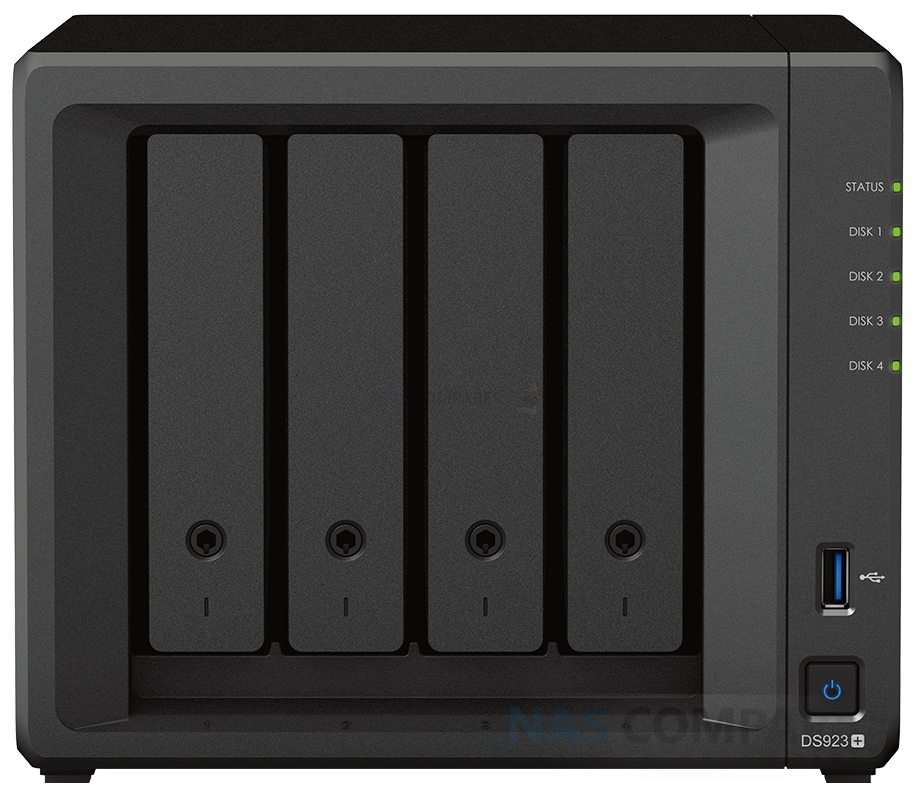
Regardless of whether you are new to NAS or have been well-grounded in the world of premium turn-key private server ownership, there is a pretty high chance you heard about Synology! In the world of NAS, they are pretty much the top brand and with good reason. Their DSM platform has continued to evolve into a complete ecosystem of tools, services and gives a number of SaaS and PaaS alternatives in the market a run for their money, despite their hardware occasionally playing it a tad safe. Every 2-3 years we see their portfolio of solutions have updates and refreshes across the board, which is exactly what brings us to the focus of today’s review. The Synology DS923+ NAS has some particular bit shoes to fill in the form of it’s predecessor, the DS920+ – arguably one of the brand’s most popular NAS solutions in their over two decades of business! The Synology DS923+ Diskstation NAS is a device that event at its first revealed at official events in Oct’22 certainly split opinion, to put it lightly. Arriving with an AMD CPU, despite it being in a historically Intel-powerful product family (for over a decade in fact), the changes do not stop there. The Synology DS923+ NAS might just be a gamble by the company to restructure its portfolio and consolidate its already largely business-leaning position, but will buyers go along with it? Is Synology planning ahead for a change in the mindset of NAS buyers that those same buyers are not quite on board with? Ultimately, does the DS923+ deserve to be the successor to the popular and award-winning DS920+, and does it deserve your data? Let’s crack on with the review and find out!
Note – If you are interested in how the Synology DS923+ and DS920+ NAS compare in terms of hardware, software and scalability, you can find out more by visiting the article HERE on NASCompares, or watch my comparison of the DS920+ vs DS923+ HERE on YouTube.
Synology DS923+ NAS Review – Quick Conclusion
Synology has clearly made something of a gamble in the release of the Synology DS923+ NAS. There is no avoiding that making the switch from the Intel Celeron that has historically been the build choice of this product family and opting for the AMD Emb.Ryzen has ruffled some feathers! On the face of it, the R1600 here has a heck of alot of going for it over the previous generation! Higher clock speed, greater PCIe Gen 3 Support throughout, that 4-32GB of DDR4 memory in such a compact system and just generally giving you a lot more horsepower to play with, as well as better bandwidth potential inside and out! But at what cost? The 1GbE standard connectivity in the base model leaves alot to be desired, the proprietary 10Gb upgrade (though incredibly handy) limits the upgradability a tad and the lack of an integrated graphics processor is likely going to result in many long-term Synology advocates to skip this generation. Synology Diskstation Manager (DSM 7.1 at the time of writing) still continues to impress and although the brand still continues to heavily push their 1st party priorities, they have left a little more wriggle room in DSM 7.1 than DSM 7 before it in terms of media compatibility. In terms of design, I cannot fault Synology on this as the DS923+ chassis still arrives as one of the best-looking and still exceptionally well-structured devices at this physical scale and storage level. As always, a Synology NAS is more about the software than the hardware (and the DS923+ delivers in spades on the software side!) and with DSM 7.2 around the corner improving things. Just always keep in mind that the Synology DS923+ NAS is a system that arrives with the slight emphasis on having to do many things ‘their way’. If you are less technically versed, then you will definitely appreciate this level of user-friendly design and assistance, but more technically minded admins’ main strain a pinch! In short, the DS923+ IS a good NAS drive, but its focus has certainly ebbed more towards the business user this generation than the home.
| Where to Buy a Product | |||
|
|
    
|

|
VISIT RETAILER ➤ |
 |
    
|

|
VISIT RETAILER ➤ |
Synology DS923+ NAS Review – Packaging
I won’t spend too long talking about the external packaging of the Synology DS923+ NAS, as it is remarkably similar to that of other Diskstation devices at this scale. The presentation of the retail box does have more attention to detail than you might expect though (given this is a 99% online purchased device and therefore any kind of glossy/detailed livery is almost a vanity addition!), as alongside the expected Synology logo and sticker for the model ID, the box is printed with tonnes of devices specific details. Synology has always been very, VERY aware of the power of branding with their solutions, as its little details like these (as well as embossed handles and favouring solution/every-man related terminology over cold specifications on the packaging) go a long way to set them apart from the sea of brown-box-rinse-repeat found in most online IT solutions you buy online and not at retail.
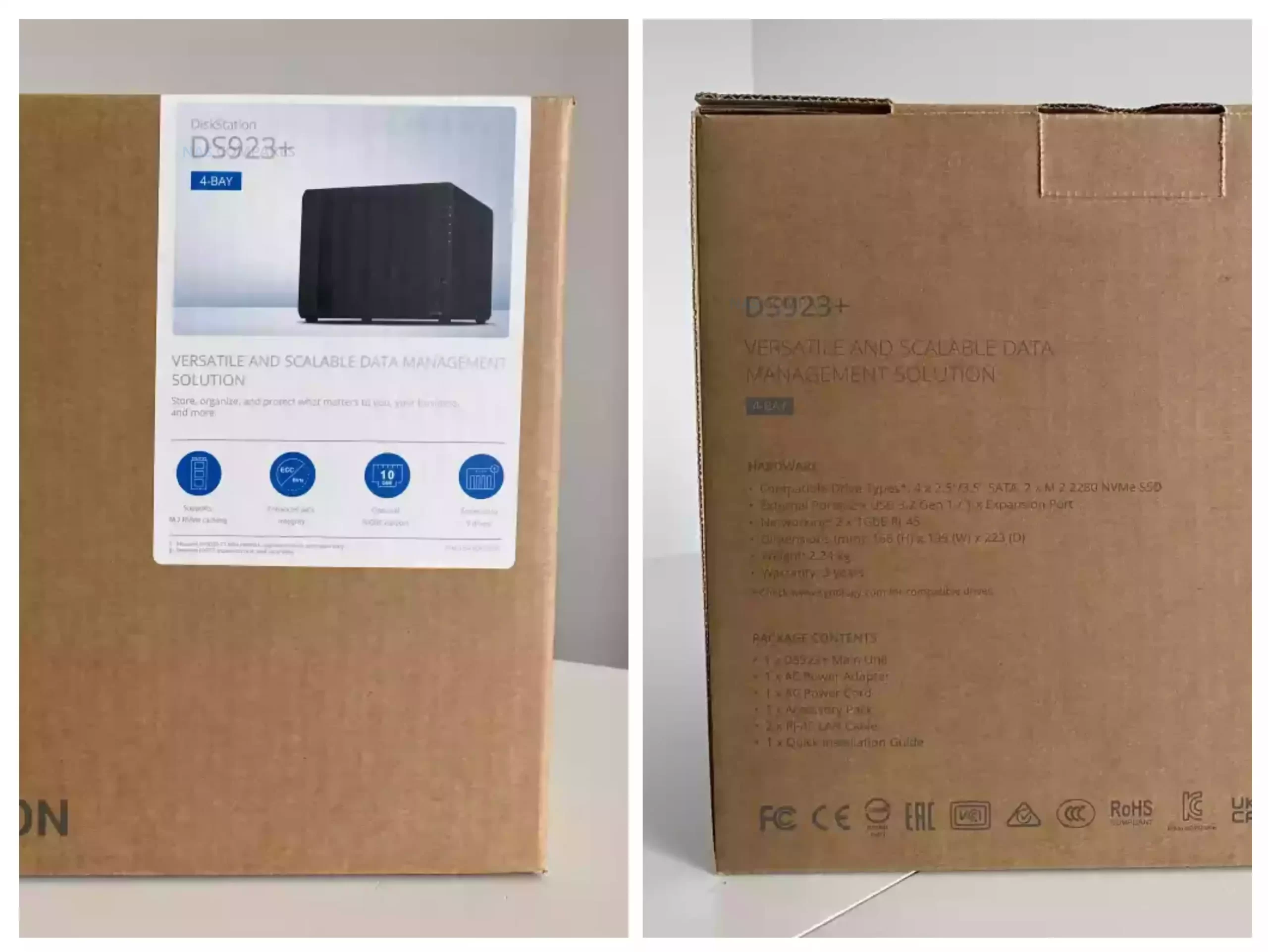
Despite the fact the DS923+ NAS is shipped unpopulated from Synology, we still need to grade/review them on the protection this unit is afforded in transit. As solid as a lot of IT kit looks, you cannot ignore the effects of shock or motion damage on them in long-distance travel from their point of manufacture (Taiwan in this case), so I will always give a brand extra points if they have gone the extra mile to spend a little more on protecting their system. In the case of the Synology DS923+ NAS, it’s mostly ok. I wish they used more hard foam/surrounding as you find in their 6-Bays and higher solutions (DS1621+, DS1821+, etc), as the DS923+ NAS arrives in a mostly cardboard structure that I think will be fine for the most part, but wouldn’t stand up to physical pressure tremendously well. Everything is separated very well and the structure/framework is there, it is just mostly cardboard! But I am being a bit petty here… let’s move on!
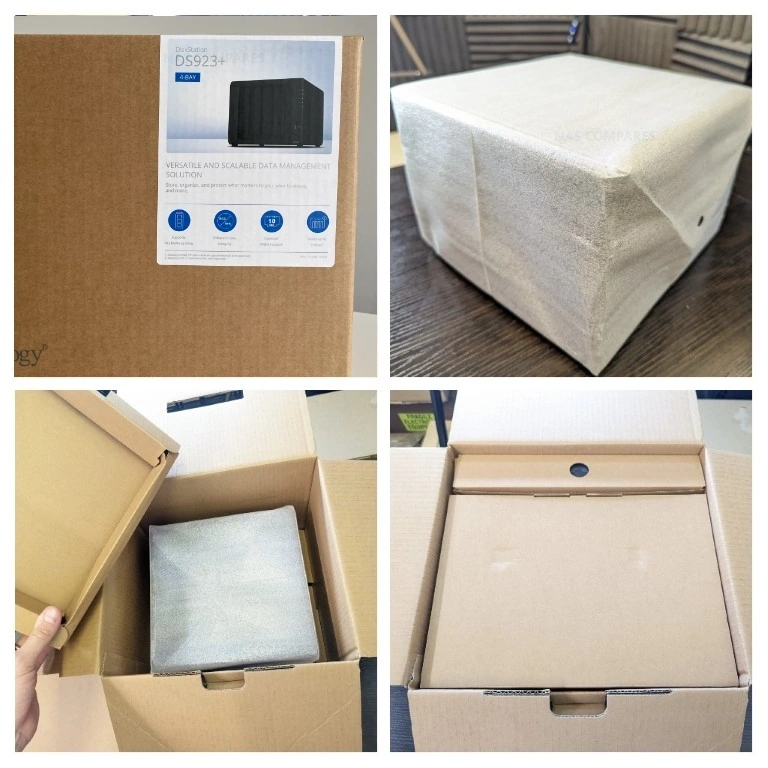
The DS923+ arrives with the accessories you would expect. The NAS unit itself, an external 100W PSU, Screws for 2.5″ media (3.5″ media installation is toolless), RJ45 Cat 5e ethernet cable, keys for the storage bays, first-time setup document and information on your warranty. All fairly standard stuff, though I am always surprised by the fact that Synology never include heatsinks for the M.2 NVMe SSD bays, given the high priority of the brand towards caching on these storage bays – something that can get those M.2 SSDs pretty hot.
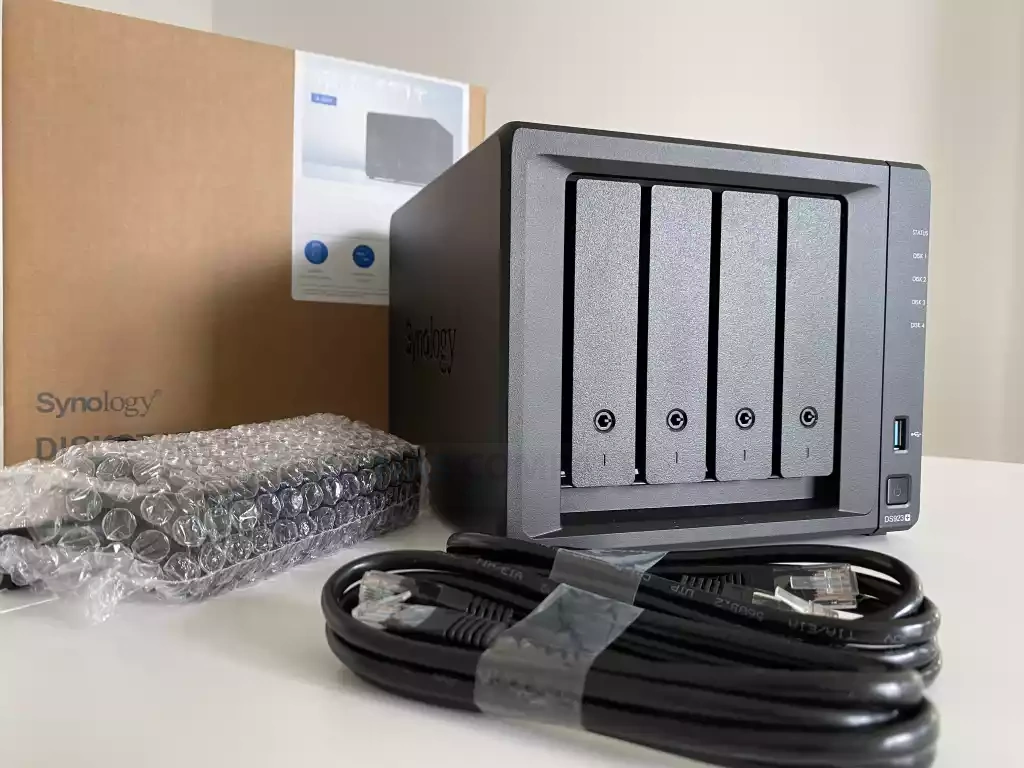
The external PSU is Synology branded, always a nice touch, and although there is a contingent of users that prefer an internal PSU (less fuss, tidier) I will always prefer an external power supplier, as it is hugely easier to replace, reduces the size of the NAS chassis itself and keeps those internal temps a little lower too. Luckily this NAS is such a low-impact model in terms of power use that a modest external power brick is completely possible.
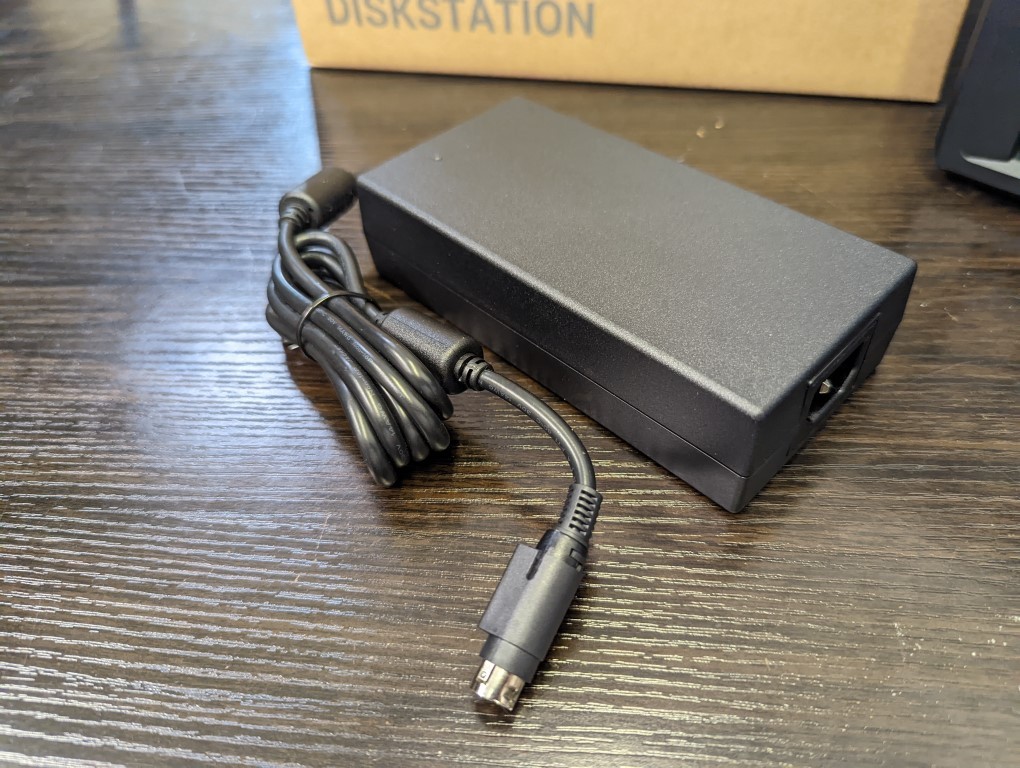
The retail kit for the Synology DS923+ NAS is all fairly standard stuff in contents, but still a very branded package and completely what we would have expected from this very brand-aware company! Let’s discuss the design of the DS923+.
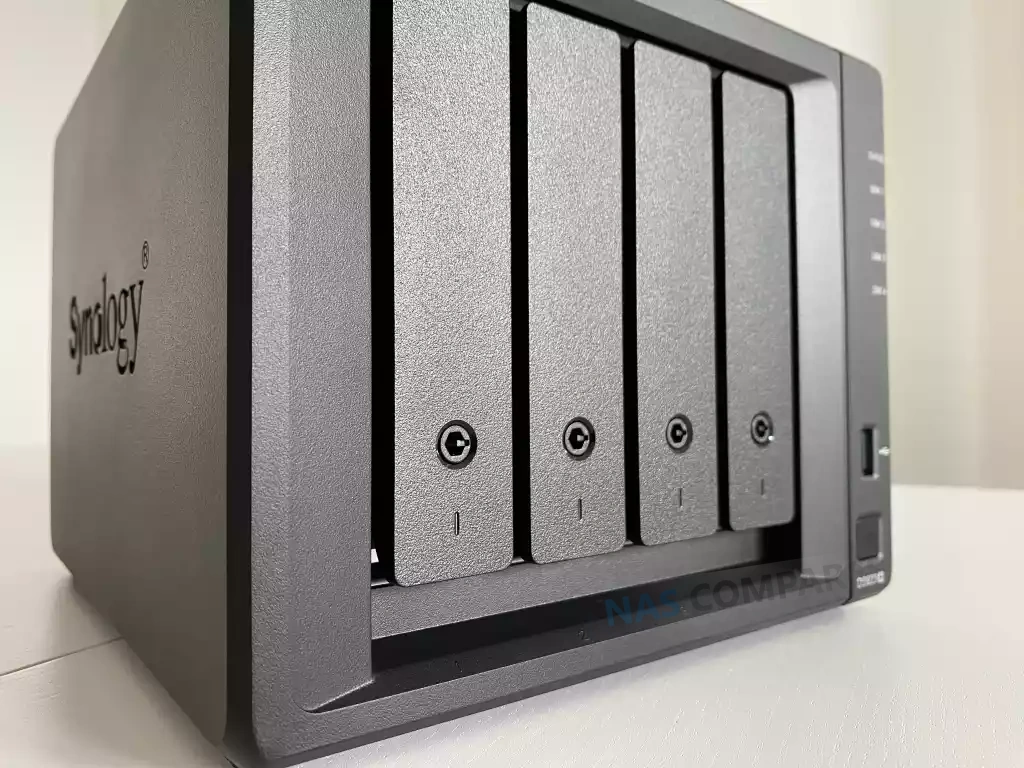
Synology DS923+ NAS Review – Design
The chassis design of the DS923+ NAS is largely the same as the DS920+ and DS918+ that came before it. This is a particularly well-designed device, both in terms of aesthetic design AND it’s efficient system operation 24×7, with tonnes of ventilation throughout and very structured component distribution. Also, the chassis is a largely plastic external casing in matt black, that contains a much smaller structure on aluminium internally. The result is a NAS that is pretty low noise when in operation (unless you use HDDs larger than around 10TB and/or enterprise-grade 7200RPM disks), something that alot of users who plan on taking advantage of the potential increased external bandwidth that DS923+ for photo/video editing will hugely appreciate. That said, one consistent vibe you get in the design of the DS923+ is that direct/physical interaction with the device is kept to a minimum, preferring almost entirely network/internet-based interactivity. Not a huge surprise for a ‘NAS’ of course, but there are a handful of physical attributes that are intentionally absent here. The front of the chassis lacks any kind of LCD display, instead favouring LED indicators. The bulk of the front panel is occupied by the main storage bays and these have alining of ventilation all around them to act as passive airflow.
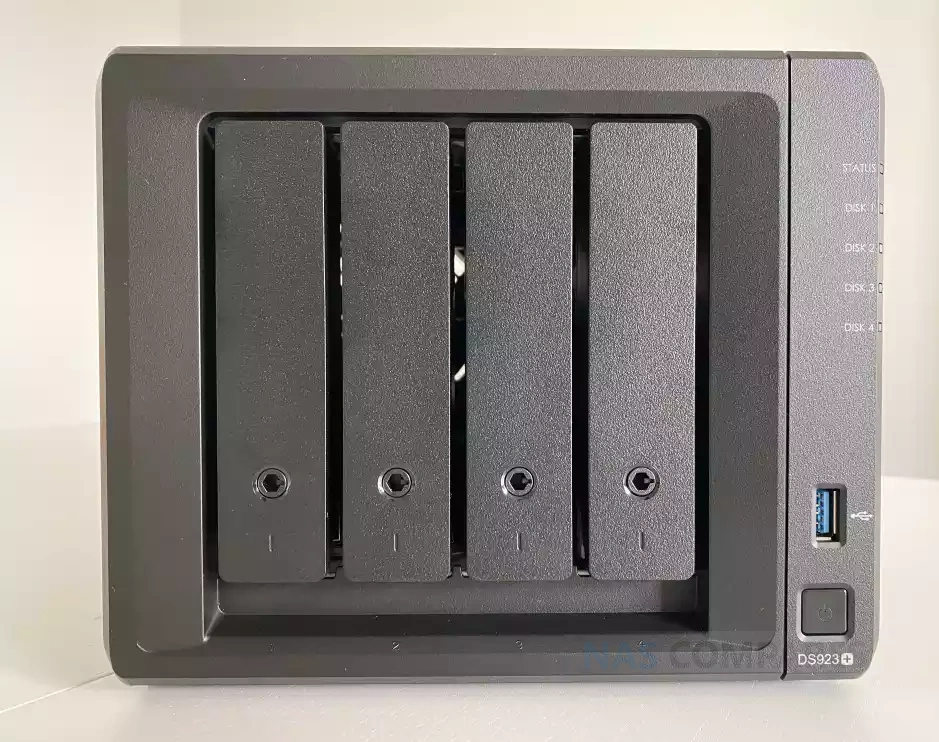
Passive airflow is definitely a big focus on the design of this chassis, with almost every side of the case featuring ventilation of one sort of around, with the Synology logo being vented. As this system will be in operation 24×7, it is heavily reliant on the rear fans to push air effectively through the system and over the assortment of internal heatsinks as effectively as possible and this chassis does that very well indeed. The Diskstation series at the 2/4 Bay level has always done a great job of melding modern design with necessary system temperature management and the DS923+ is no exception.
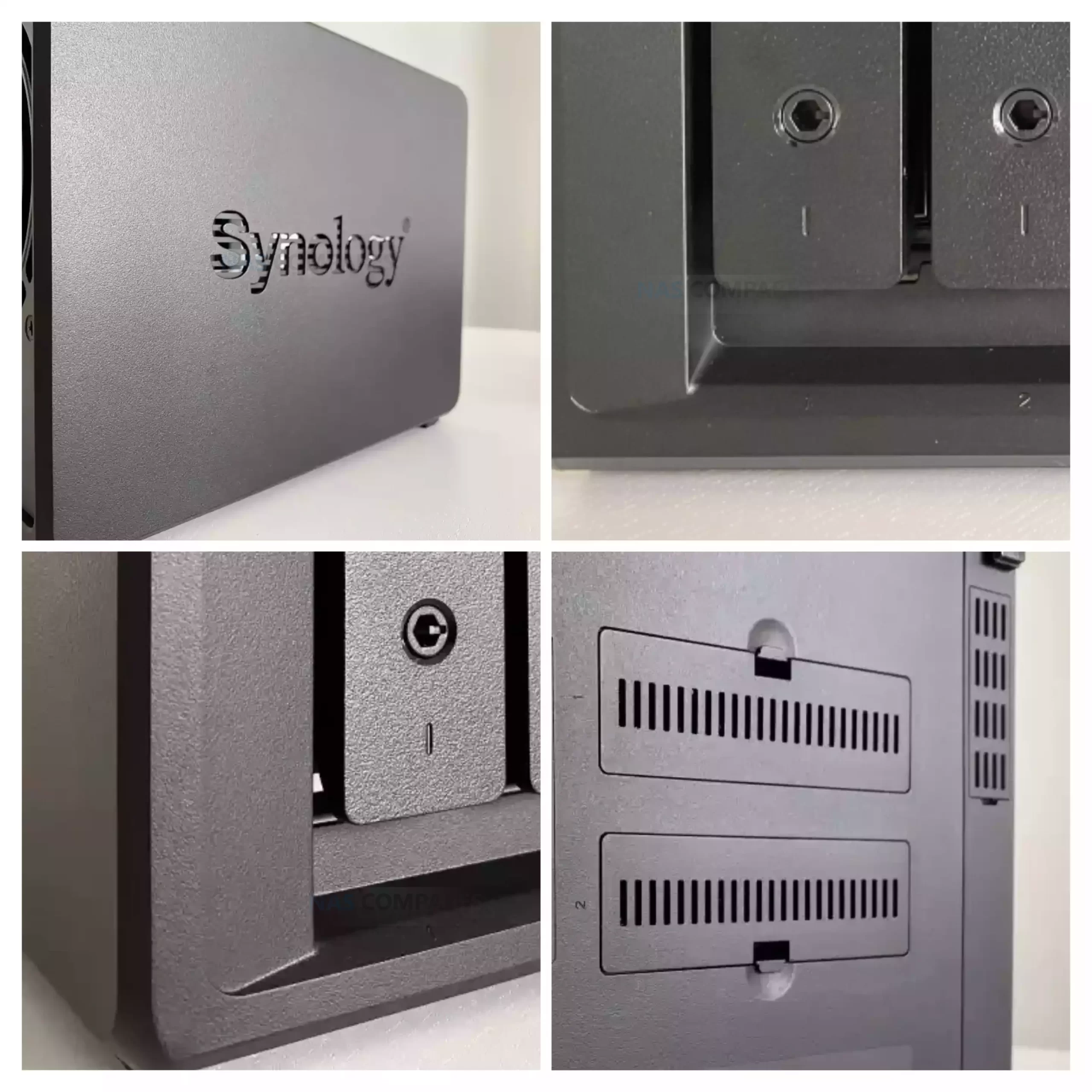
The LEDs on the front of the system use the usual three-colour system to denote drive activity and system status (network activity is absent, but the usual LEDs on the RJ45/Ethernet ports themselves are still present). These can have their brightness adjusted (or deactivated entirely) and although lack alot of the more information abilities of an LCD panel (IP addresses, system temp, alert description), they still serve ok as an initial indicator of system activity.
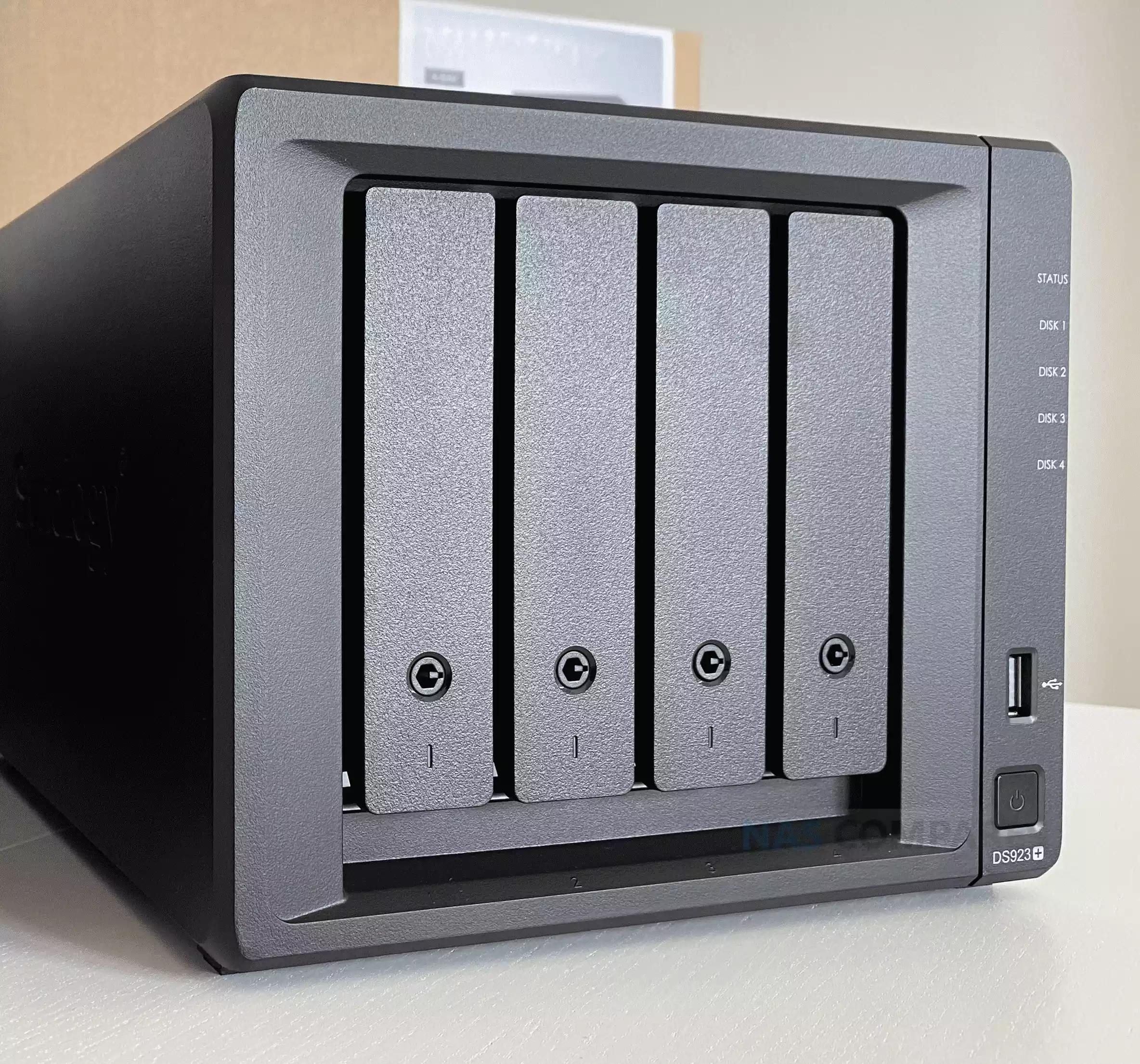
The main four storage bays of the DS923+ NAS are SATA interfaces and can be fully or partially populated with 2.5″ or 3.5″ media. The HDD/SSD compatibility of the DS923+ is still thinner than that of the DS920+, but Synology softened its stance a pinch on this subject after DSM 7.1 and the negative feedback on stricter HDD compatibility (i.e Synology media only). Although the full compatibility list is not as broad as that of the DS920+, we expect more drives to be added after launch (much as we saw with the DS1522+ and RS422+), though drives above 18TB are still absent (at the time of writing) despite 20TB and 22TB hard drives being tested on the DS923+ and working immediately. These four bays also allow you to use a large range of RAID configurations (redundant array of independent disks – a system of combining multiple drives to benefit storage scale, performance and/or data redundancy/safety-net). The usual configurations are here, RAID 0, RAID 1, RAID 5 and RAID 6, but the system also supports Synology’s Hybrid RAID (SHR) which allows you to mix different HDD/SSD capacities. It’s pretty unlikely that you will mix drive media on day 1, but if you partially populate or want to upgrade your drives gradually a few years down the line, SHR is SIGNIFICANTLY easier to expand and absorb newer/larger drives into an existing RAID. That said, the performance of SHR is a pinch lower than RAID 5, so for those hoping to take advantage of the 10GbE connectivity might do well to think about their Day 1 RAID and it’s impact down the line.
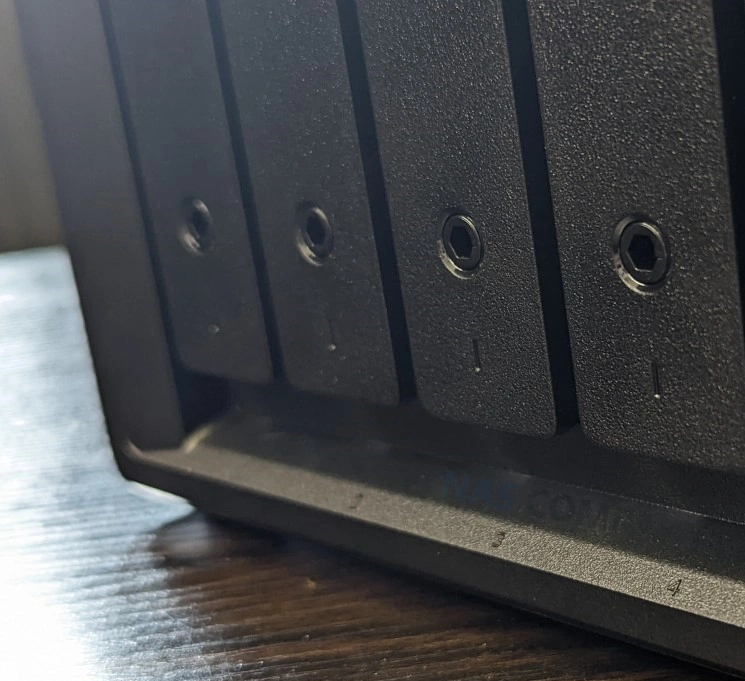
The trays themselves are plastic click-n-load tracks that feature a locking mechanism. It’s worth highlighting that this lock is by no means ‘industrial’ and removing a drive is going to be easy for particularly nefarious individuals, but this lock is more to prevent accidental removal than it is as a meaningful security barrier. The trays have screw holes for 2.5″ media to be installed with screws, but 3.5″ media is installed in seconds with the use of side clips that hold the drive in place via it’s own fixtures. The plastic tray is pretty sturdy and heat/cracking is not going to be any concern here. Also, the plastic trays will lower the ambient noise level when in operation more than metal trays would do, but (sorry to be repetitious) if you use bigger than 10TB HDDs, it is simply not possible to reduce the clicks, hums and whurs of these more industrial drives.
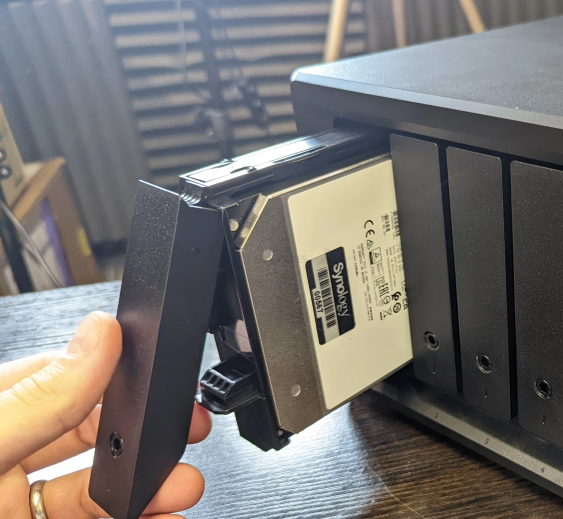
The front of the DS923+ NAS also features a USB port that can be used for connecting an external drive for backups in either direction (i. backup the drive contents to the NAS, or present files and folders to the NAS to the drive). Now, the DS923+ does not feature a front-mounted copy button (bit annoying) but DSM does include a USB copy tool that allows drives to automatically trigger a pre-set USB-to-NAS or NAS-to-USB operation when a drive is connected, which is pretty detailed in its setup (pre-set directories, age of files, exclusions, schedules, versioning, etc).
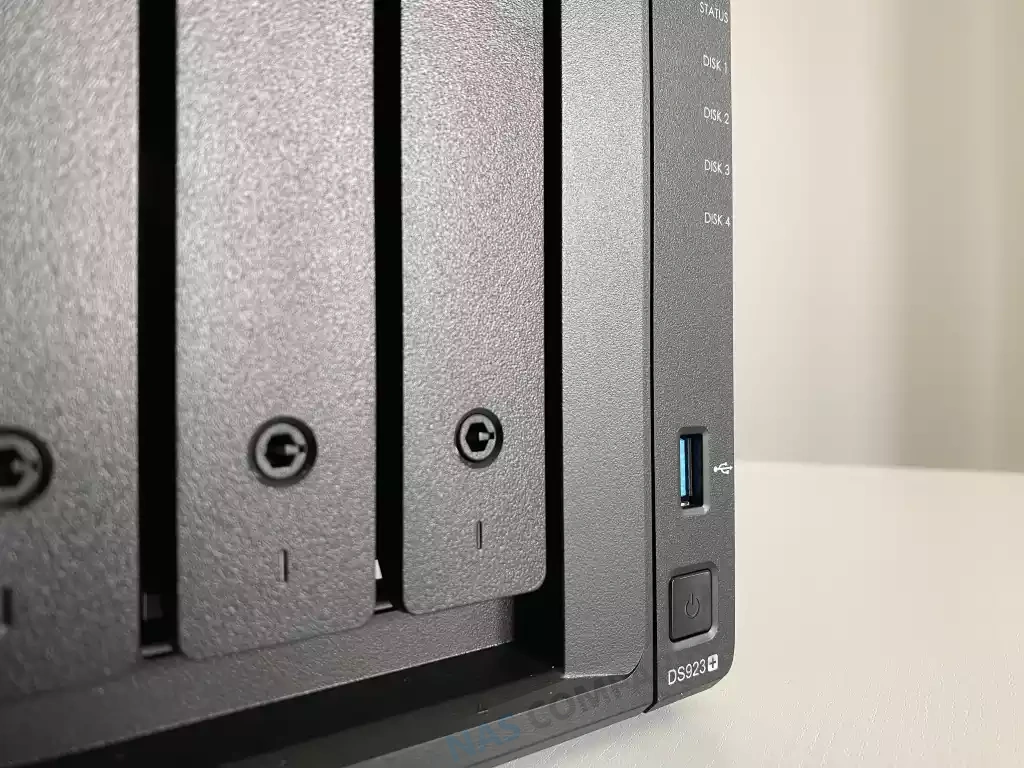
Taking a look at the base of the DS923+ NAS shows us those two m.2 NVMe 2280 SSD slots, each with a ventilated top panel. These two slots support a PCIe Gen 3 SSD in each bay (which can be partially/fully populated) in order to take advantage of SSD caching in the Synology storage system. Caching can consist of Read Caching (when more frequently accessed data is copied to the faster SSD to allow faster retrieval later, though the benefits are only really felt/observed in smaller data) and Write Caching (When data being uploaded/sent to the NAS is initially written to the SSDs and then moved to the internal larger/slower HDD RAID array.

As beneficial as this sounds, it is still a pain that (at the time of writing) these NVMe SSD bays cannot be used for raw storage pools, as there are a number of popular 1st/3rd party applications that would hugely benefit. Still, as more and more Synology NAS systems arrive with M.2 slots AND these are all predominantly PCIe Gen 3×4 in the 2021/2022/2023 generation, I would not be surprised if wesee Synology decide to change their position on this in a future DSM update. For now though, these fast SSD bays are restricted to cache use only (though a workaround will no doubt arrive on a GitHub page near you soon enough!).
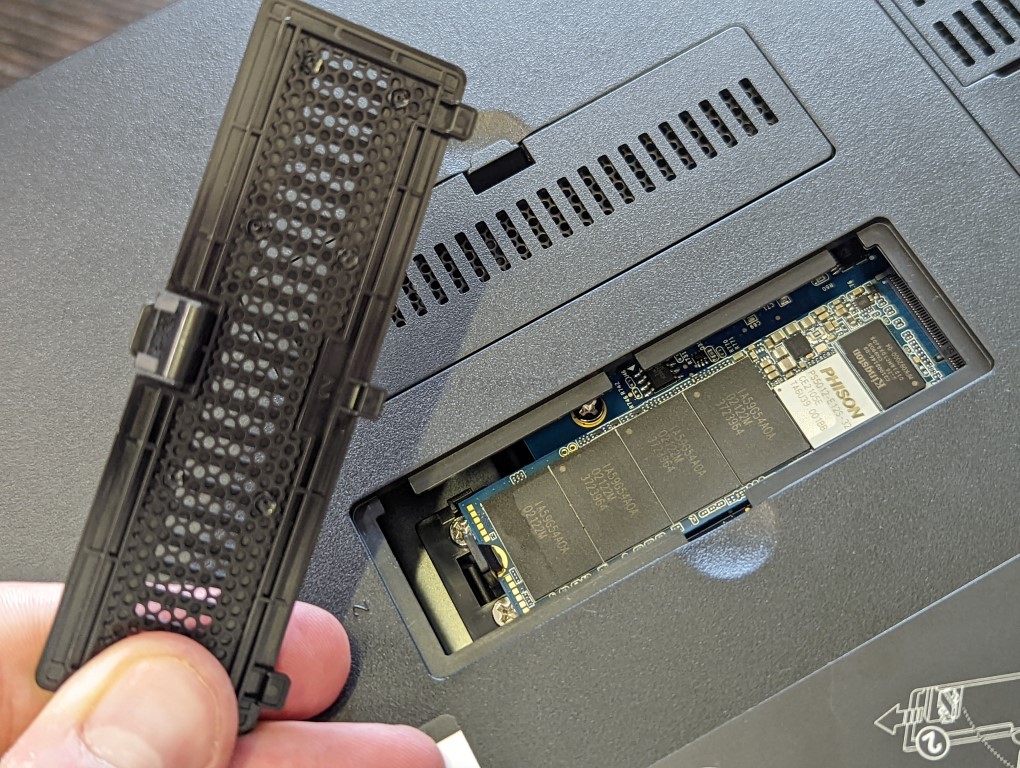
I have always been a big fan of the Synology Diskstation chassis for it’s minimalistic, yet attractive and efficient design. The absence of a USB copy button still irks me a little and the largely plastic design is not going to be to everyone’s taste, but you cannot fault the amount of R&D that has gone into the construction here. Let’s discuss the ports and connectivity of the DS923+ NAS.
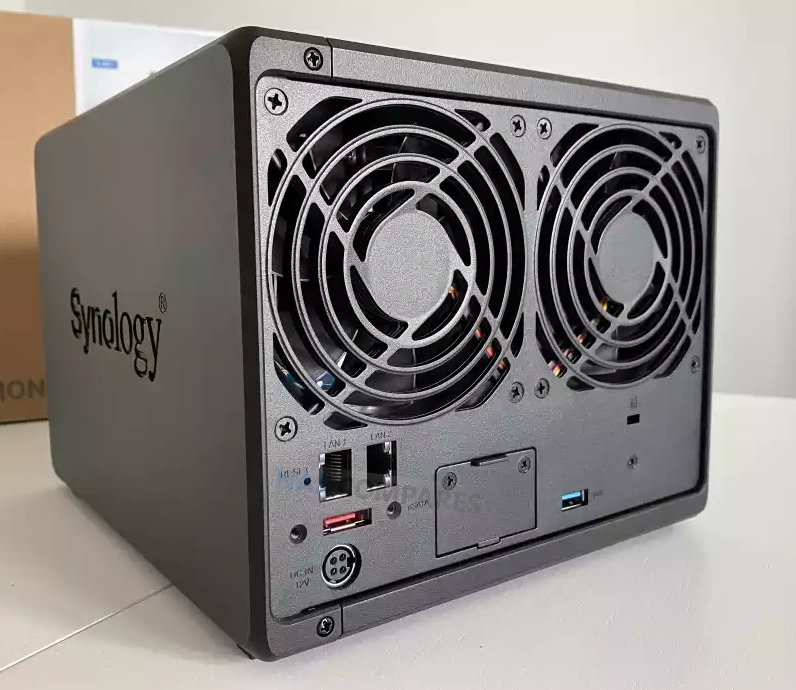
Synology DS923+ NAS Review – Ports and Connections
The ports and connections that the DS923+ NAS arrives with are something of a mixed bag and compared with the 2020 released DS920+ only real include on different (but it IS a BIG difference). The system has two active cooling fans (2x 92mm) that will automatically adjust their RPM as the system’s ambient temperature requires. You can adjust these manually if you are especially noise-sensitive, but I would really recommend it (a low system temp = better system efficiency). The fans are not removable (built into the back panel of the system), so cleaning and maintenance are a little fiddly, but thanks to the large amount of ventilation afforded to the system, this is not really an issue long-term.
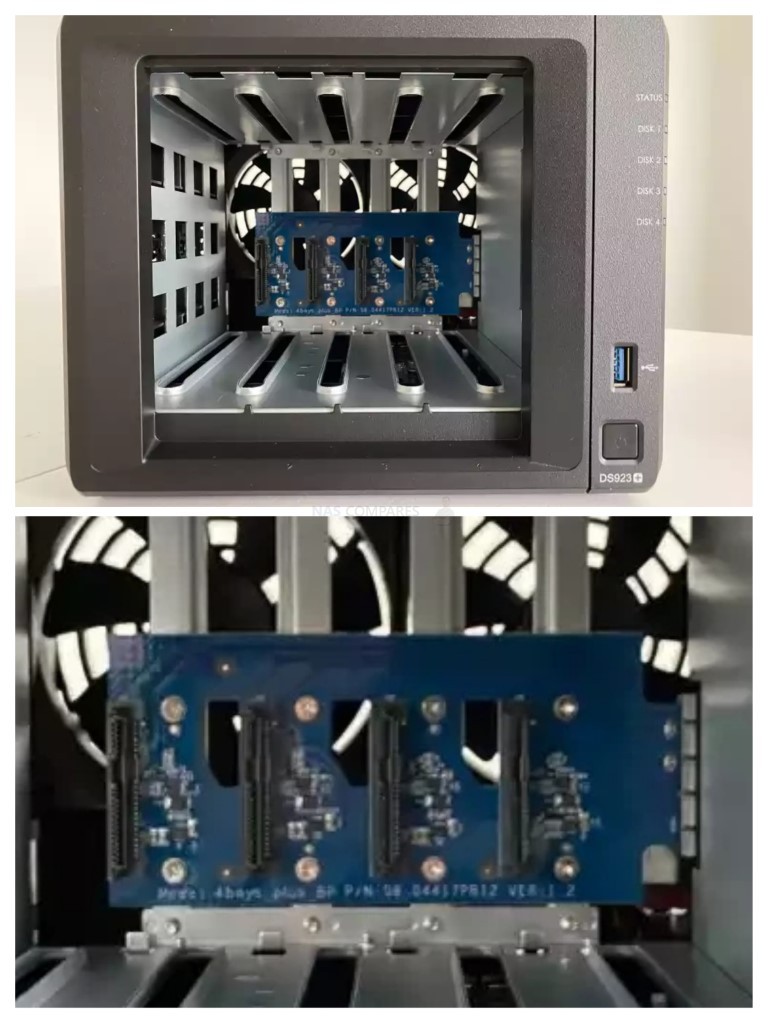
Let’s get the elephant in the room out of the way early doors! Those ethernet ports. The default model of the DS923+ NAS arrives with two-gigabit ethernet ports (the same as the DS920+, DS918+ and DS916+ before it), despite almost other commercial NAS brand producing solutions at this consumer-tier/scale arriving with at least 2.5GbE. Now, the adoption of greater than gigabit connectivity in client hardware (laptops, PCs, routers, switches, docking stations, etc) is by no means as ubiquitous as 1GbE (which has been around for decades at this point), BUT it is growing. ISPs are providing fiber internet connections globally that exceed gigabit speeds, along with 2.5GbE and WiFi 6 routers. We are seeing more prosumer switches, routers and PCs with default 2.5Gb network ports (at the same/similar cost as 1GbE), $20 USB-to-2.5G adapters and even the affordability of 10GbE on some client devices has allowed users to gradually scale up their hardware environment. The fact the DS923+ arrives at the tail end of 2023 and does not feature greater than 1GbE ports by default is quite damning. Even if you have no plans for 2.5G right now in your setup and think it something of a fad (favouring 10GbE), in terms of future-proofing and the general standard or networking hardware right now, gigabit ethernet is a surprising weakness here.
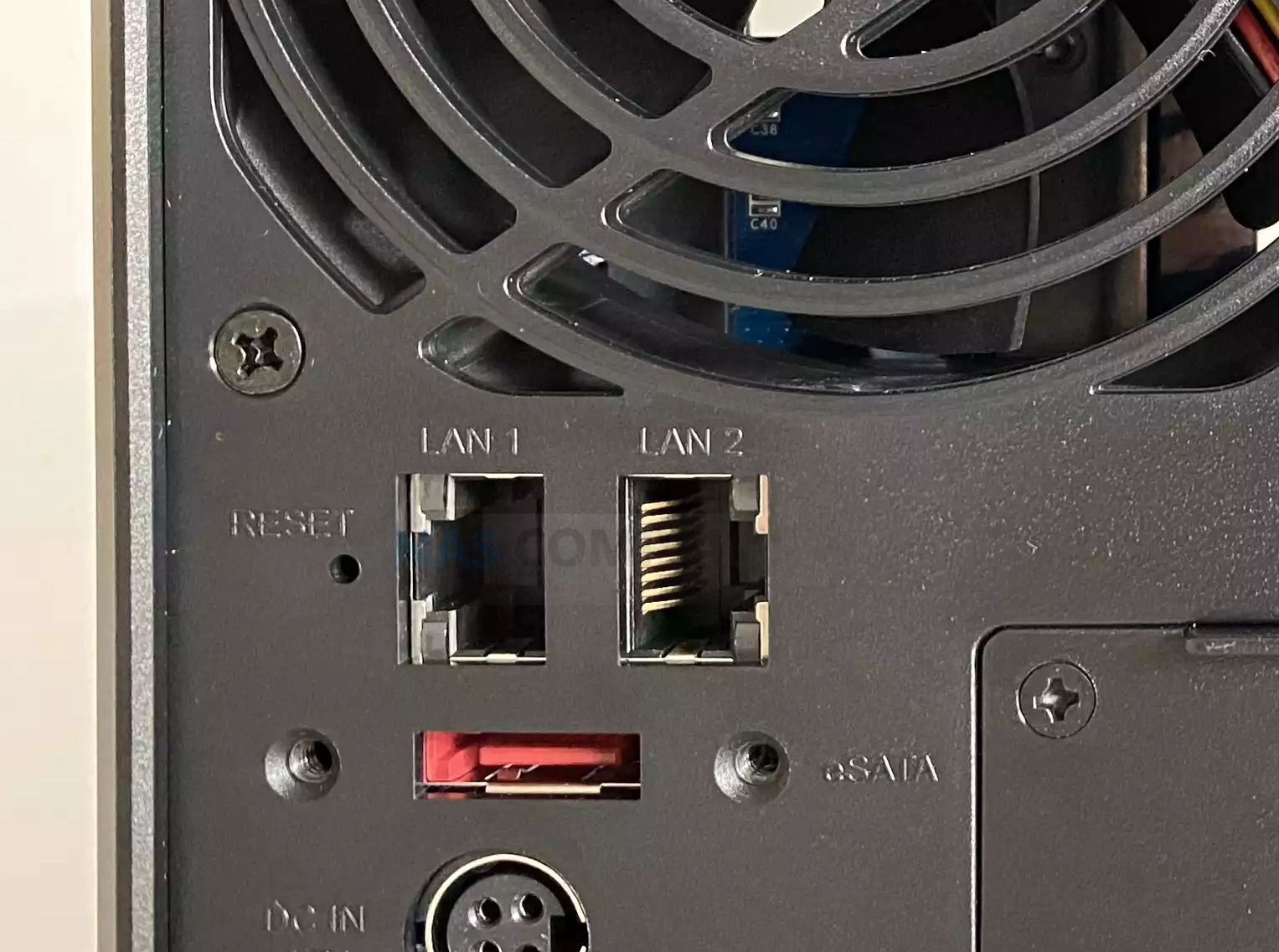
HOWEVER, we do need to acknowledge the bit change that the DS923+ brings over it’s 2.5yr older predecessor – the ability to upgrade your network connectivity to 10GbE. The DS923+ is now the 3rd Synology NAS to arrive (after the DS1522+ and RS422+) with support of the Synology E10G22-T1-mini, a proprietary network upgrade module that is one of the easiest and quickest upgrades that I have ever seen to 10G to install! This module fits neatly (by design of course) into the PCIe Gen 3 x2 network upgrade slot, though powering down the device is necessary during installation. At first, I was a little sceptical about Synology providing a 10GbE upgrade to the DS923+ via a custom-made and largely proprietary designed upgrade module (thereby limiting you to ONLY the Synology PCIe upgrade, but not any other traditional PCIe Card 10G upgrades), but over time I have come round a little on this one.
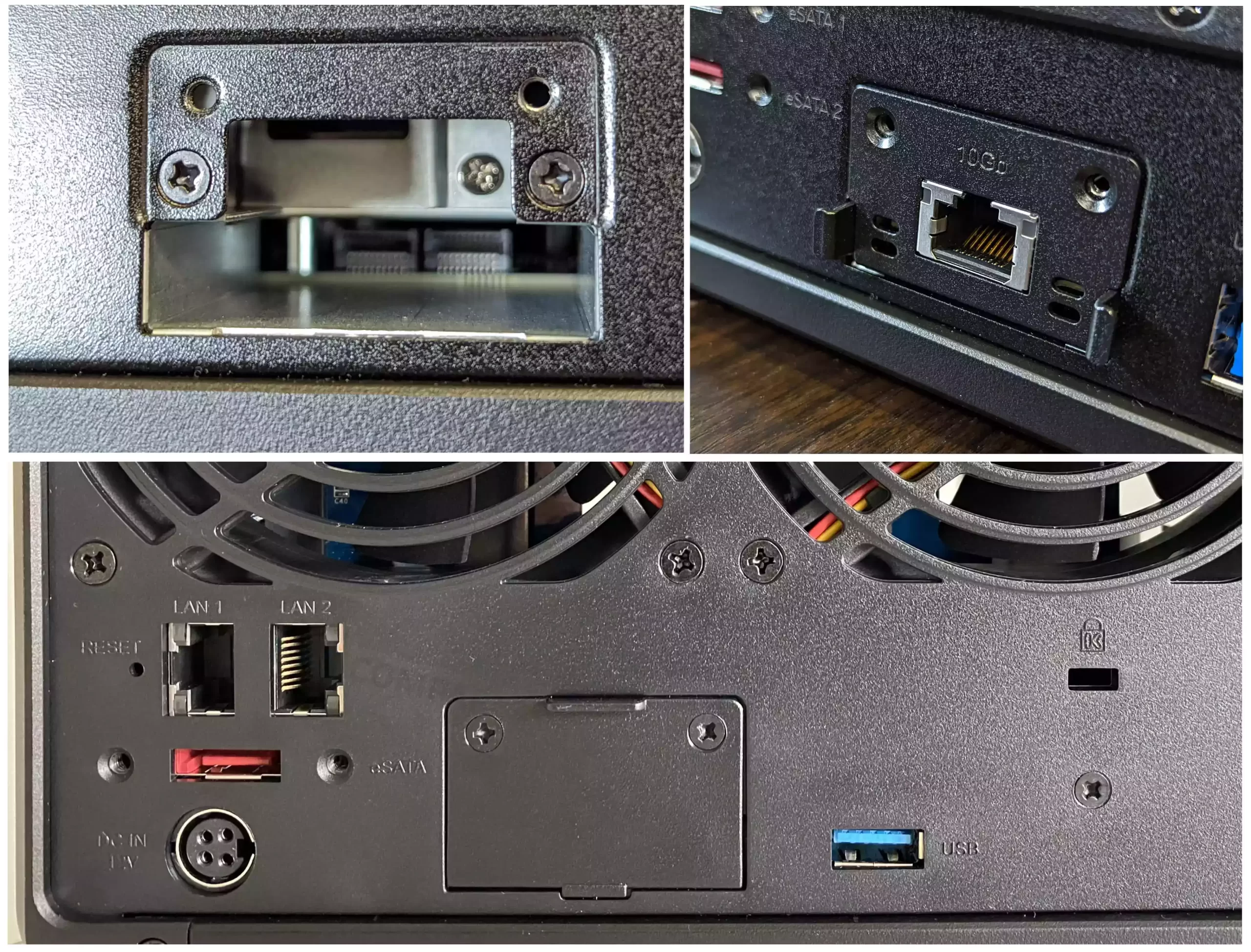
I like how easy this is to install (zero case deconstruction) and it is a very well-designed component (not just a rebadged card with a logo). The 10G upgrade is only available in copper (RJ45/10GBASE-T) currently, but I would not be surprised if Synology roll out an SFP/SFP+ version down the line. As much as I would like to see this port and it’s utility get expanded (2.5G/5G, Dual port?), realistically this is still a PCIe 3×2 slot (so maximum 2,000MB/s to play with and that’s without network/hardware friction) and the physical space here is pretty small.
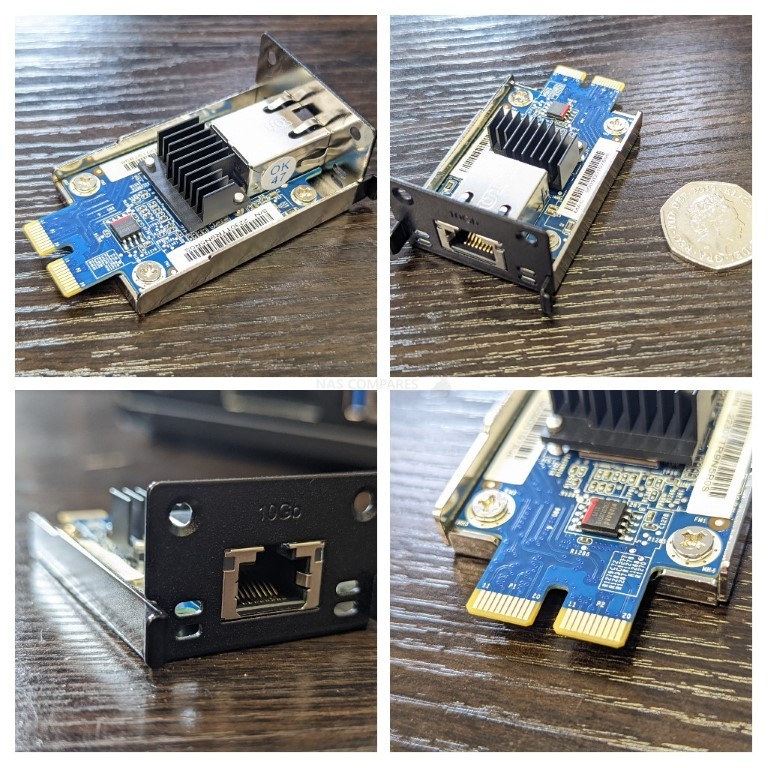
The next question many will have about the DS923+ and this optional 10GbE upgrade is, can you even saturate a 10G (1,00MB/s+) connection with 4 bays of SATA storage? It’s a good point, as generally, domestic-class NAS HDDs will give you about 180-220MB/s max, with enterprise-class (or Pro) drives giving you 250-275MB/s. RAID configuration will add to this by increasing performance per drive by around 120-200MB/s per extra drive (again, class dependant) and even Synology on their official pages stated sequential performance of 625/559 MB/s Seq Read/Write. So, is 10GbE on the DS923+ a bit ‘pie in the sky’ anyway? Well, no. As mentioned previously here on NASCompares (sorry to be repetitious) I have performed 10Gbe tests with 4x WD Red Pro 22TB Hard Drives in a RAID 5/0 on the DS1522+ (same CPU, but twice the memory) and managed on several occasions of ATTO Disk benchmark testing to hit 1GB (1.15GB/s) speeds (see below). I will be conducting more specific performance tests on the Synology DS923+ NAS later for YouTube (and updating this review accordingly), but this does pretty much show that the DS923+ have the wherewithal the saturate 10GbE in specific setups.
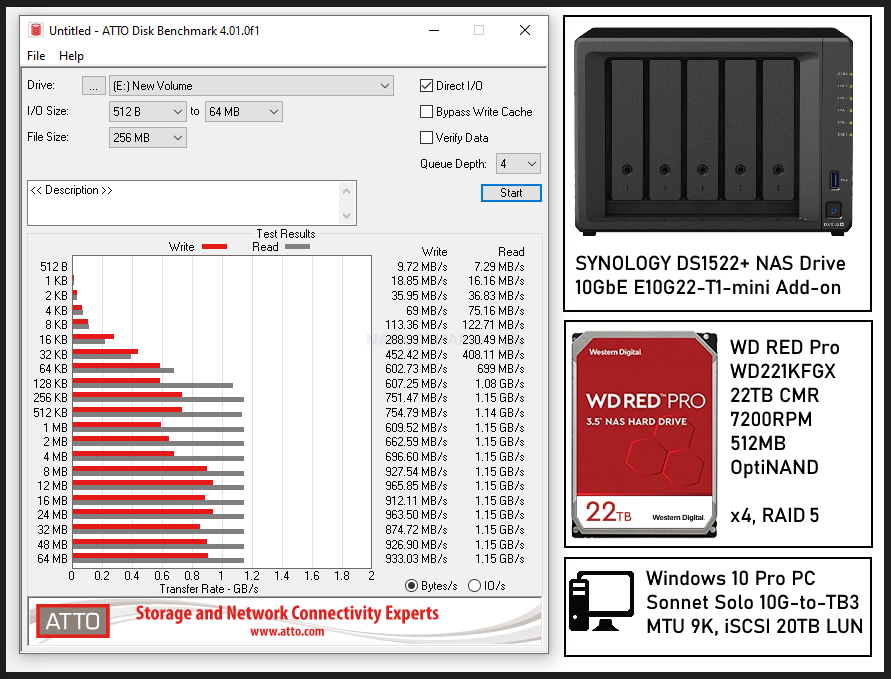
The DS923+ also have an additional USB Port on the rear and it is here that we should touch on another thing about the device that I am a little less blown away by. The USB ports here are USB 3.2 Gen 1, so 5Gb/s (500-500MB/s max bandwidth). Much like the 2.5G vs 1Gb complaints I made earlier, most other NAS brands at this hardware tier have rolled in USB 3.2 Gen 2 (10G / 1,000+ MB) ports, as well as USB-C in some cases. With the ease with which a user can add a USB tier to their 3-2-1 backup strategy (allowing them to be a little more financially creative with a network/remote/cloud backup tier as well), the slightly old skool USB ports here are a little underwhelming. With significantly more affordable RAID-enabled USB solutions in the market and/or M.2 NVMe external USB drives arriving affordable to comfortably provide faster external storage for backups, this seems like a bit of a misstep by Synology to ignore. Also, DSM 7 and DSM 7.1 (with DSM 7.2 coming soon enough) have reduced the range of use of the USB ports of Synology NAS systems (removing many network adapters, DTV tuners, wireless dongles, office accessories such as printers, scanners and optical drives), and limiting them largely to storage, UPS’ and assigning them to VMs. I am sure Synology has done the market research and observed reduced utilization of USB on their systems to dictate this decision, but it seems to be another move by the brand to prioritize network/remote access only with their systems.
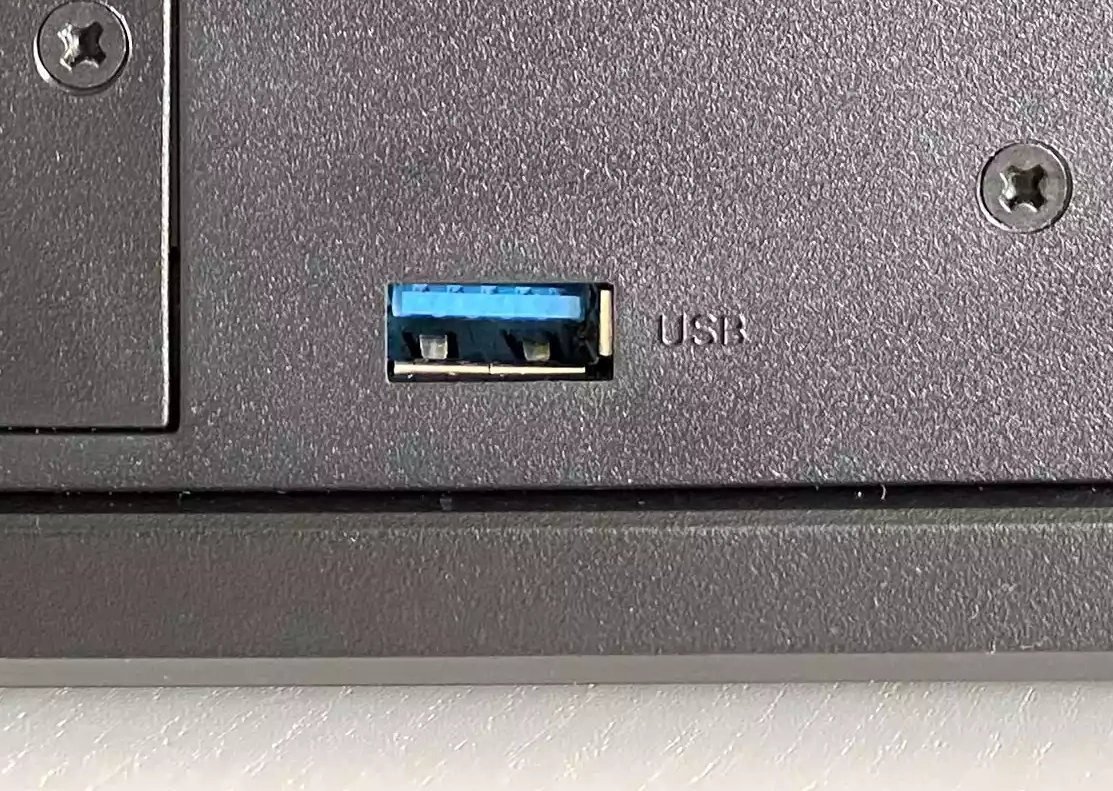
Lastly, there is the expansion port that allows you to attach the official 5-Bay DX517 expansion device. This £350-400 5x SATA Bay JBOD enclosure is connected via a screw-in eSATA connection and allows you to either expand an existing RAID to increase the drive quantity and capacity overall (though not recommended to spread RAIDs over NAS+Expansion). Alternatively, you can use the expansion as a means to create an additional separate RAID configuration (which can also be gradually populated) that is treated exactly the same as the internal storage of the DS923+. The fact this expansion is JBOD only means that the RAID is managed by the main DS923+ device (which given the expansion cost, is a little annoying), but having this expandability is very useful. You cannot use third-party eSATA JBOD enclosures (unsurprisingly) and you can not get smaller/larger expansion chassis that are compatible with the DS923+, but the support of an expansion does mean that your storage options years down the line have this official option.
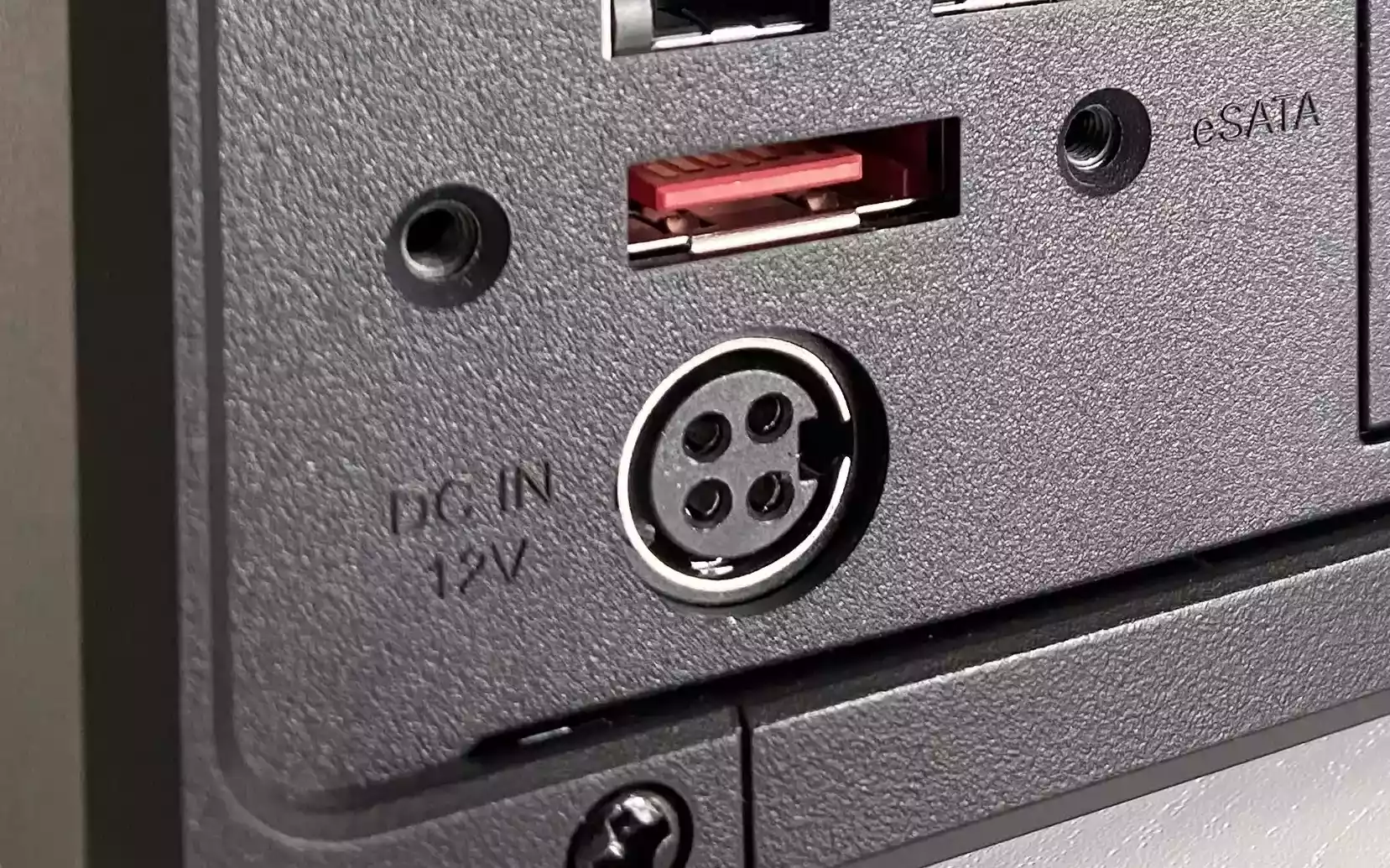
Overall the ports and connectivity of the DS923+ are technically no differences in the base model than the 2.5yrs older DS920+, it is only the option to add improved network connectivity towards 10GbE (and paying £129-139 extra for that) that makes this any way improved upon as a refresh of the older device. This upgrade is certainly welcomed, but there is still the hanging question of why they could not just roll this into the DS923+ as a default port on day 1 and just increase the price £100 – as I think there is a good % of NAS users who would have preferred this (especially with 10GbE largely supporting auto-negotiation with 5G, 2.5G and 1G, therefore allowing backwards compatibility). The expandability in storage and USB support remains exactly the same too, which is a little ‘meh’. Let’s take a closer look at the internal hardware and discuss the other big changes that the DS923+ brings over its predecessor.
Synology DS923+ NAS Review – Internal Hardware
This is likely to be one of the biggest areas of contention for many users who have been waiting for the release of the DS923+, as the hardware choices that Synology has made for this system are quite a change of architecture that many expected. The internal framework of the DS923+ is an aluminium storage cage for the main SATA bays, with its own multi-port backboard. The same goes for the M.2 NVMe SSD bays, with both of these boards connecting to the controller board that has CPU and Memory storage.
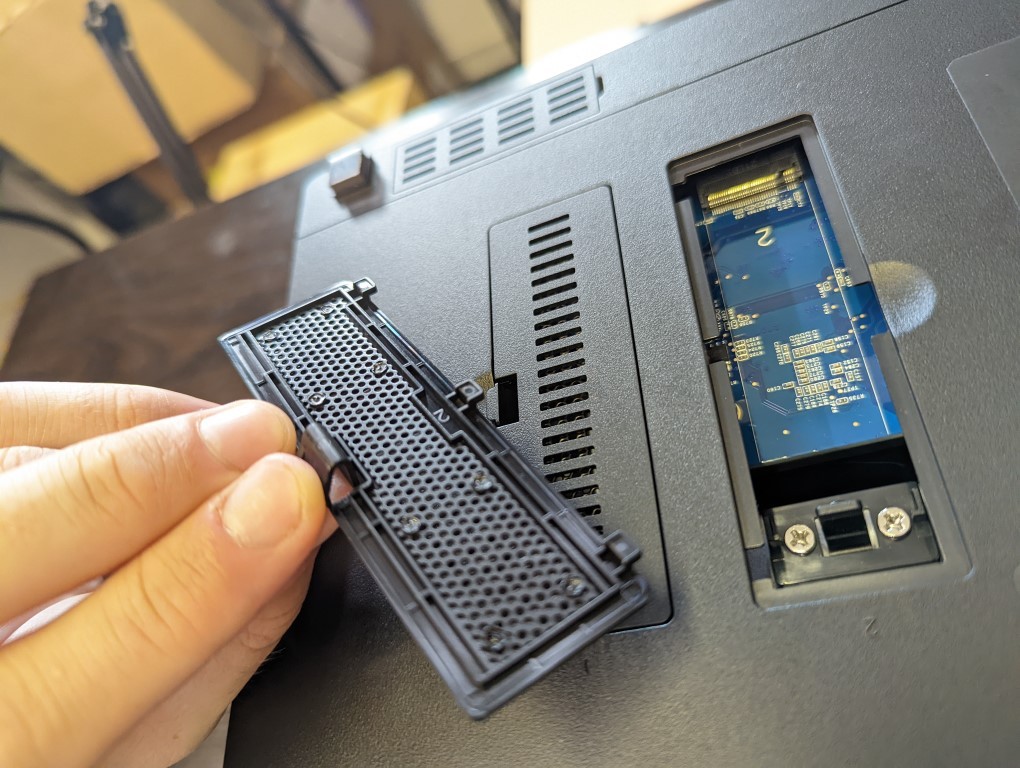
As mentioned earlier, the DS923+ does not take advantage of any active cooling systems (beyond the rear fans) and is heavily reliant on heatsinks internally to dissipate the heat from key components like the CPU and disperse that heat into the air. The CPU inside the DS923+ is the AMD Embedded Ryzen R1600 processor, an x86 64bit Dual core, four-thread processor with an impressive base level clock speed of 2.6Ghz that can be scaled up to 3.1Ghz when needed. Now, the DS9xx+ series has always arrived with a Quad Core Intel Celeron (or Pentium) processor in the past and when it was revealed that the DS923+ was arriving with a dual-core embedded ryzen, many users were a little unhappy. This was largely down to two factors. The first was that the R1600 is a dual-core, not the four-core that everyone expected. Now the R1600’s four-thread architecture does allow the CPU to spread out quite alot across tasks and services (as well as virtual CPUs in VM deployment), as well as having a higher power in both base and burst mode available, which means it isn’t a bad CPU! But the bigger area of contention from some buyers is that the R1600 lacks integrated graphics. This means that for some tasks and services that are more graphical in nature, the result will be a higher typical CPU Uages % than a processor that has a more specialized graphics management component onboard.
How the Synology DS920+ Intel Celeron J4125 and DS923+ AMD Emb.Ryzen R1600 Compare:
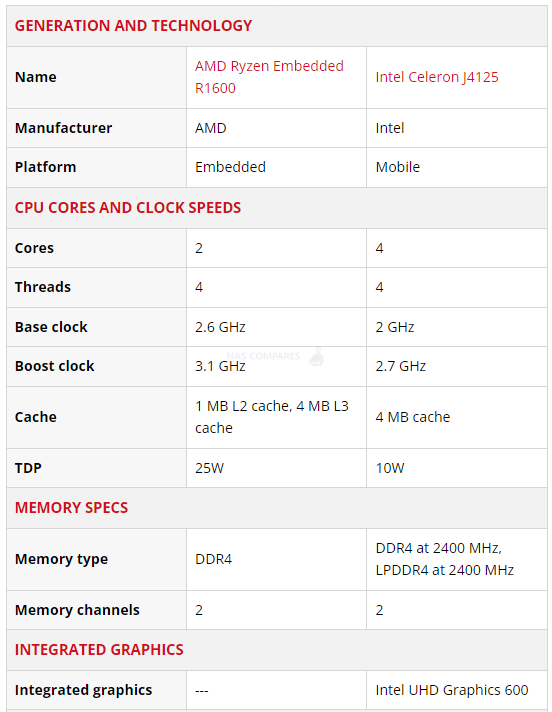
The traditional data handling of the R1600 is very good, as seen in our DS1522+ testing earlier in 2022. As far as DSM (the Synology software) is concerned it will be able to run EVERYTHING! Additionally, the general file handling and throughput internally are going to be great too, so all good news. Then you have the advantage of the newer gen CPU in the DS923+ over the DS920+ supporting PCIe3 lanes, affording greater bandwidth to the rest of the hardware (i.e those M.2 slots being higher bandwidth and enabling that network upgrade slot), all the while with the CPU having the potential to hit 3.1Ghz of power when needed. It is genuinely a good CPU and there are lots of reasons why Synology have opted for this CPU, but it is by no means perfect and some specific user setups and their concerns do have merit.
For a start, the AMD R1600 has a higher typical usage (unsurprising for the spec and generally identified as TDP, as a maximum) compared with the avg Intel Celeron being used in other NAS systems released in 2022 (such as the Intel N5105 or J6412) and in a system that will be in operation 24×7, this is going to a question mark for those affected by erratically rising energy prices right now, The difference might only be pence on the day, but those pence add up! Then there is the dual cores. Although having the four threads IS handy and will be useful, Cores will always beat threads when it comes to capabilities. Finally, there is that lack of integrated graphics. Most users will not notice this as an issue in day-to-day use, but multimedia users and especially a large % of Plex users will notice, if they are a little more reliant on the server-side processing than on the client. For example, if your media collection contains alot of dense/complex audio media (RAW, MP4a, etc) OR alot of higher-end HEVC/H.265 Media BUT you do not have client hardware that supports these types (or allows local client conversions/transcoding), then the NAS will have to use raw horsepower to get the job done – much less efficient than embedded graphics doing the job. Again, you might not be impacted by this (your client hardware might have enough power and privileges, or you own a local HEVC-licensed device), but it IS a concern if you are running a Plex Media Server on the DS923+ and need the NAS to convert files on the fly. Earlier in 2022, I compared the DS920+ (with a Celeron) vs the DS1522+ (with this same AMD R1600) in a detailed YouTube video testing 4K Media in Plex. Here are the results:
Next, we can move on to the other big internal change that the DS923+ NAS has arrived with over the DS920+ before it, the Memory. The DS923+ arrives with 4GB of DDR4 Memory like it’s predecessor – but after that, it is all change! This memory is ECC (Error Correcting Code) memory that is more often found in enterprise NAS setups, due to its higher pricetag, but also its huge benefits towards avoiding bitrot and silent data inconsistency that are not going to be spotted till years down the line when accessing old data. As data passes through the memory, the memory has an additional onboard module that is designed to be constantly making a blueprint/snapshot/parity bit of the data at the start. This is then used to check the data on the exit path and if there are any inconsistencies, the data is remapped/repaired to its original form.
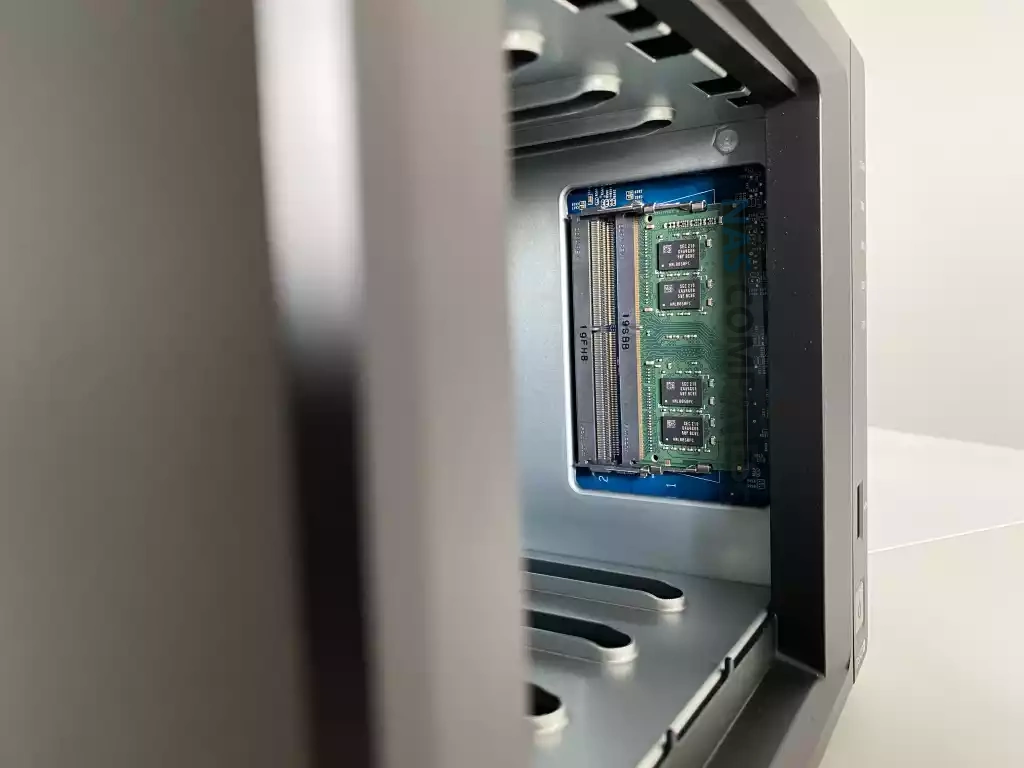
ECC Memory has appeared on lots of Synology NAS’ over the years (with pretty much ALL devices higher than ‘mid-high business having it as standard now), so it is great to see it here on this 4-bay diskstation model. In other good news, whereas the DS920+ had 4GB of memory that was soldered to the main controller board and could be upgraded to 8GB with 1 free slot, the Synology DS923+ has two slots available (one prepopulated with the initial module) and can be upgraded to a massive 32GB. This again is thanks to that R1600 CPU being used. Although Synology still maintains quite a tight compatibility/whitelist on supported memory modules (stating that you can/should ONLY use their own first-party modules), I cannot fault the choice of memory and its upgradability here!
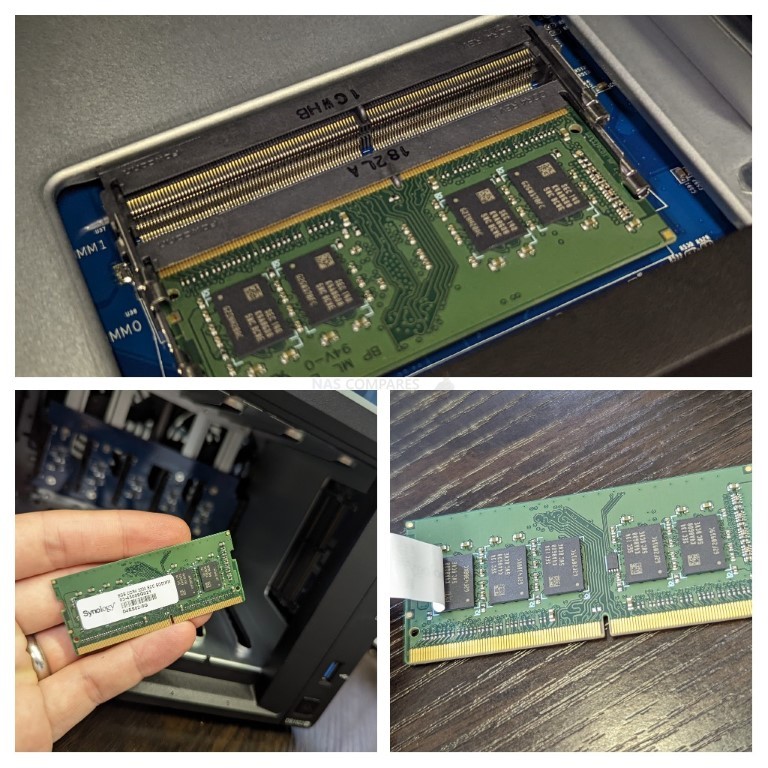
In summary, in terms of the internal hardware, I am mostly happy. The lack of an integrated graphics processor (especially when the same AMD Embedded Ryzen R1000 CPU family has a graphics-equipped model, which was passed over here for the R1600) is a real pain for alot of users, but by no means does it mean this NAS is a write-off! That CPU has alot of capabilities, has opened up the hardware on the system to greater bandwidths, is capable of great internal+external performance and outside of conversion-based activities in multimedia, and still plays 4K and 1080p media very well. There are a few other details regarding AMD Emb.Ryzen vs Intel Celeron that you can learn more bout by reading this article HERE, but let’s move on to the Software side of the Synology DS923+ NAS and DSM 7.
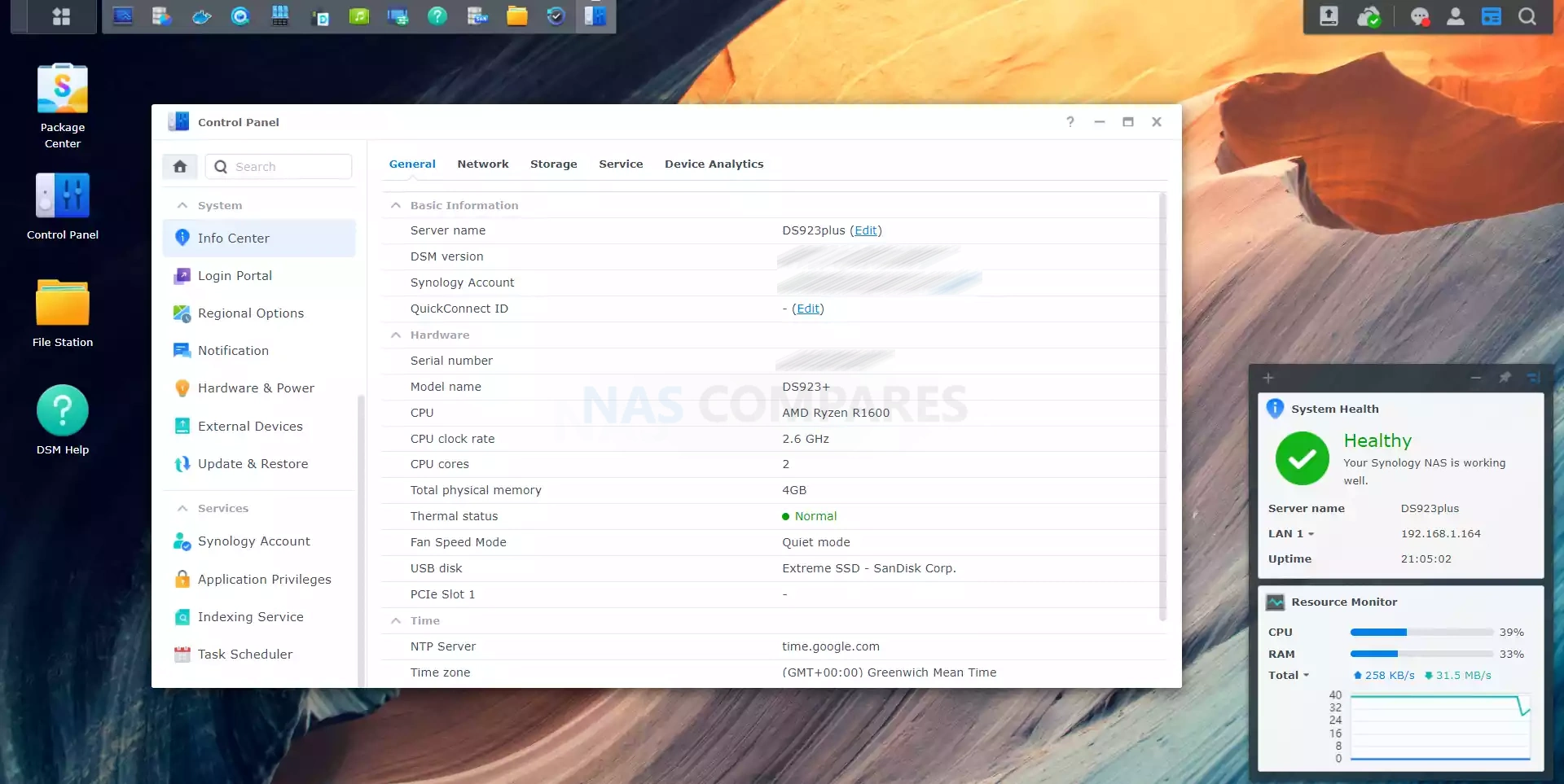
Synology DS923+ NAS Review – Software and Services
At Launch, the DS923+ NAS arrives with the latest version of Synology software, DSM 7.1. However, this does not stop evolving as soon as you get your Synology NAS. DSM has been in continues to be the dominant force in the world of NAS software, providing a massive arrangement of services, applications (first and third-party supported) and a huge number of client applications for desktop, mobile, Windows, macOS and Linux (as well as a bunch of other more home-based tools). These allow management and access to the data on the DS923+ in very tailored ways, as well as the web browser-based access that has the appearance, intuitive design and responsiveness of a local operating system. The DSM interface can be accessed by hundreds of users at the same time (with each user having tailored access, rights and privileges). DSM is available with ALL Synology NAS and the depth and abilities of DSM on any NAS are dependent on the hardware architecture of the NAS itself. In the case of the Synology DS923+, it supports EVERYTHING that is offered by Synology’s platform. DSM is currently in version 7.1, but it looks like we will be seeing beta/full release of DSM 7.2 at the end of 2022 or the start of 2023, which will be adding WORM (write Once Read Many) support, Volume scale encryption and numerous improvements to individual applications. If you want to learn about the DSM 7 and the software and services that are included with the DS923+ NAS, watch my FULL review below (alternatively, you can read the DSM 7 Full Review HERE):
As mentioned, the DS923+ supports pretty much the entirety of the DSM 7.1 applications and services (DSM 7 and DSM 6.2 are still in circulation and still receive regular service and security updates, though the DS923+ will arrive with DSM 7.1 by default and cannot be rolled back). If you are an existing user of SaaS and PaaS (Software as a service and Platform as a service) from the likes of Google Workspace and Office 365, knowing that you can synchronize these systems or choose to export away from them onto the Synology services is going to be very appealing. Then there is the increasing development of their 1st party cloud platform, Synology C2, which is slowly integrating into all the applications that are available on your bare metal NAS (allowing you to add a cloud layer of backup, synchronization and access to your data storage setup). This is a subscription platform, which can only be used with your Synology NAS system (as well as connected with some 3rd party SaaS services, but for those that are moving away from Google/Microsoft/AWS for security reasons, but still want a Cloud+Metal storage network in place, C2 covers pretty much everything. Indeed, although below I have highlighted a number of the key/best applications that are included in your DS923+ Service with DSM, most of them can be immediately integrated with Synology C2 (with even more being added in 2023 with DSM 7.2). Key business and consumer applications that are included with your NAS are:
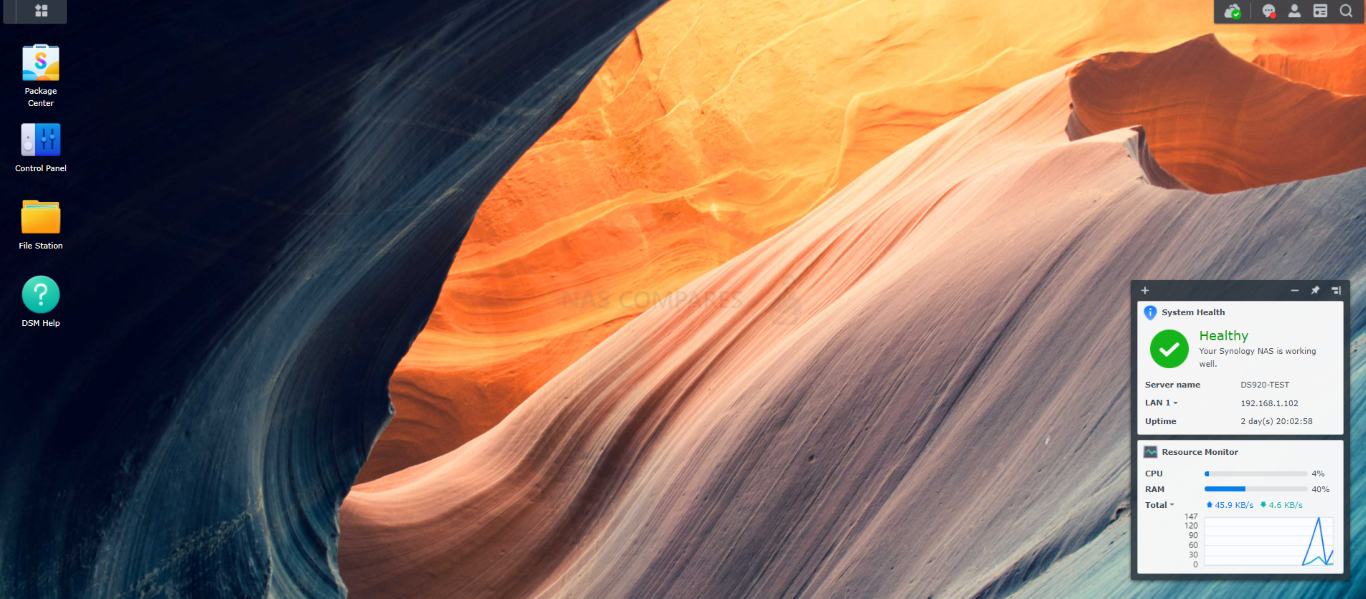
Synology Office – Create documents, spreadsheets, and slides in a multi-user environment. Real-time synchronization and saving make collaboration a breeze.
Synology Chat – Aimed at businesses, Synology Chat is an IM service that transforms the way users collaborate and communicate.
Synology Drive – Host your own private cloud behind the safety of your NAS with 100% data ownership and no subscription fees. Drive has become one of the premier applications of DSM and allows uses to create intelligent shared team folders that support versioning, file streaming+pinning, encryption, Windows AD support (soon) and native file system support with Windows and macOS.
Synology Photos – Manage your photos and videos with deep-learning algorithms that automatically group photos with similar faces, subjects, and places. Designed after the merger of Synology Photo Station and Moments, it also includes tailored folder, sharing and categorization features to help photographers manage their photos and share them with clients for feedback or business development.
Synology Calendar – Stay on track, share calendars, and schedule meetings, while ensuring sensitive information remains safely stored on company premises.
Synology Active Backup for Business (ABB) – Consolidate backup tasks for virtualized environments, physical servers, and personal computers, and rapidly restore files, entire machines, or VMs – license-free. This software also arrives as a specialised Microsoft Office 365 and Google Workspace platform to sync with those platforms and allow a bare metal tier to your cloud office services
Synology Hyper Backup – Backup your NAS safely and efficiently to multiple destinations with deduplication, integrity checks, compression, and versioning.
Synology Surveillance Station – Safeguard your business, home, and other valuable assets with reliable video surveillance tools. With improved AI services being accessible thanks to Synology BC500 and TC500 Cameras arriving in 2023. Additionally, you can connect this platform with Synology’s cloud platform to use ‘C2 Surveillance’ and bolster the odds of recordings being maintained in the event of accidental/malicious damage to your surveillance system.
Synology Virtual Machine Manager (VMM) – An intuitive hypervisor that supports Windows, Linux, and Virtual DSM virtual machines. Its powerful disaster recovery tools help users achieve maximum service uptime.
Synology High Availability – Synology High Availability (SHA) combines two Synology NAS servers into one active-passive high-availability cluster, alleviating service disruptions while mirroring data.
Synology Central Management System (CMS) – Synology CMS allows you to manage multiple Synology NAS servers quickly and conveniently from a single location.
Synology Video Station – Manage all your movies, TV shows, and home videos. Stream them to multiple devices or share them with friends and family.
Synology Audio Station – Manage your music collection, create personal playlists, stream them to your own devices, or share with family or friends.
Synology File Station – Manage your Synology NAS files remotely through web browsers or mobile devices. This tool allows complete file management and contains all the features and services of your own native file management platform (archiving, extracting, Copy, Cut, Paste, Sharing, native file format opening, integration with the rest of the Synology applications, property/metadata access, etc)
You cannot really fault the software and services that are included with the Synology DS923+ NAS, as you are going to get the very best experience available on the platform, thanks to the hardware and architecture of this NAS. DSM 7 is an ever-evolving platform, so if you are reading this now at the time of publishing or years later, there is always going to be something in DSM for everyone. That said, Synology in recent years has been increasing its priorities towards first-party software and services. This does make sense, as they want to promote their systems and software as a complete ecosystem for your home or business data storage needs (going on in the last few years to release even more Synology alternatives to popular software AND releasing non-NAS hardware accessories such as Routers, Network Adapters, HDDs, SSDs and now IP Cameras). This can occasionally lead to the compatibility lists of hardware or software that you wish to use in conjunction with the DS923+ NAS being a little smaller/restricted than you might like. A specific 3rd party software/service or physical accessory (HDD, Memory module, Network Upgrade) might not appear on the Synology compatibility pages, but that does not mean it will not function with the DS923+ NAS. It is more a case of Synology choosing not to test/evaluate a particular setup (in their defence, there are ALOT) and therefore until stated otherwise is therefore listed as incompatible and is therefore being used without their full, guaranteed support long term. In short, you can DEFINITELY feel that DSM 7/7.1 is a fantastic NAS platform, but it comes with a certain degree of rigidity by Synology on the DS923+ NAS. A little more relaxed than entries in the Enterprise XS or SA systems, but it is definitely still there.
NOTE – Video Review is ‘In Progress’ and will include the 10GbE and DSM 7.1 Testing, which will also be added to this review shortly afterwards. Apologies for the delay.
Synology DS923+ NAS Review – Conclusion & Verdict
Synology has clearly made something of a gamble in the release of the Synology DS923+ NAS. There is no avoiding that making the switch from the Intel Celeron that has historically been the build choice of this product family and opting for the AMD Emb.Ryzen has ruffled some feathers! On the face of it, the R1600 here has a heck of alot of going for it over the previous generation! Higher clock speed, greater PCIe Gen 3 Support throughout, that 4-32GB of DDR4 memory in such a compact system and just generally giving you a lot more horsepower to play with, as well as better bandwidth potential inside and out! But at what cost? The 1GbE standard connectivity in the base model leaves alot to be desired, the proprietary 10Gb upgrade (though incredibly handy) limits the upgradability a tad and the lack of an integrated graphics processor is likely going to result in many long-term Synology advocates to skip this generation. Synology Diskstation Manager (DSM 7.1 at the time of writing) still continues to impress and although the brand still continues to heavily push their 1st party priorities, they have left a little more wriggle room in DSM 7.1 than DSM 7 before it in terms of media compatibility. In terms of design, I cannot fault Synology on this as the DS923+ chassis still arrives as one of the best-looking and still exceptionally well-structured devices at this physical scale and storage level. As always, a Synology NAS is more about the software than the hardware (and the DS923+ delivers in spades on the software side!) and with DSM 7.2 around the corner improving things. Just always keep in mind that the Synology DS923+ NAS is a system that arrives with the slight emphasis on having to do many things ‘their way’. If you are less technically versed, then you will definitely appreciate this level of user-friendly design and assistance, but more technically minded admins’ main strain a pinch! In short, the DS923+ IS a good NAS drive, but its focus has certainly ebbed more towards the business user this generation than the home.
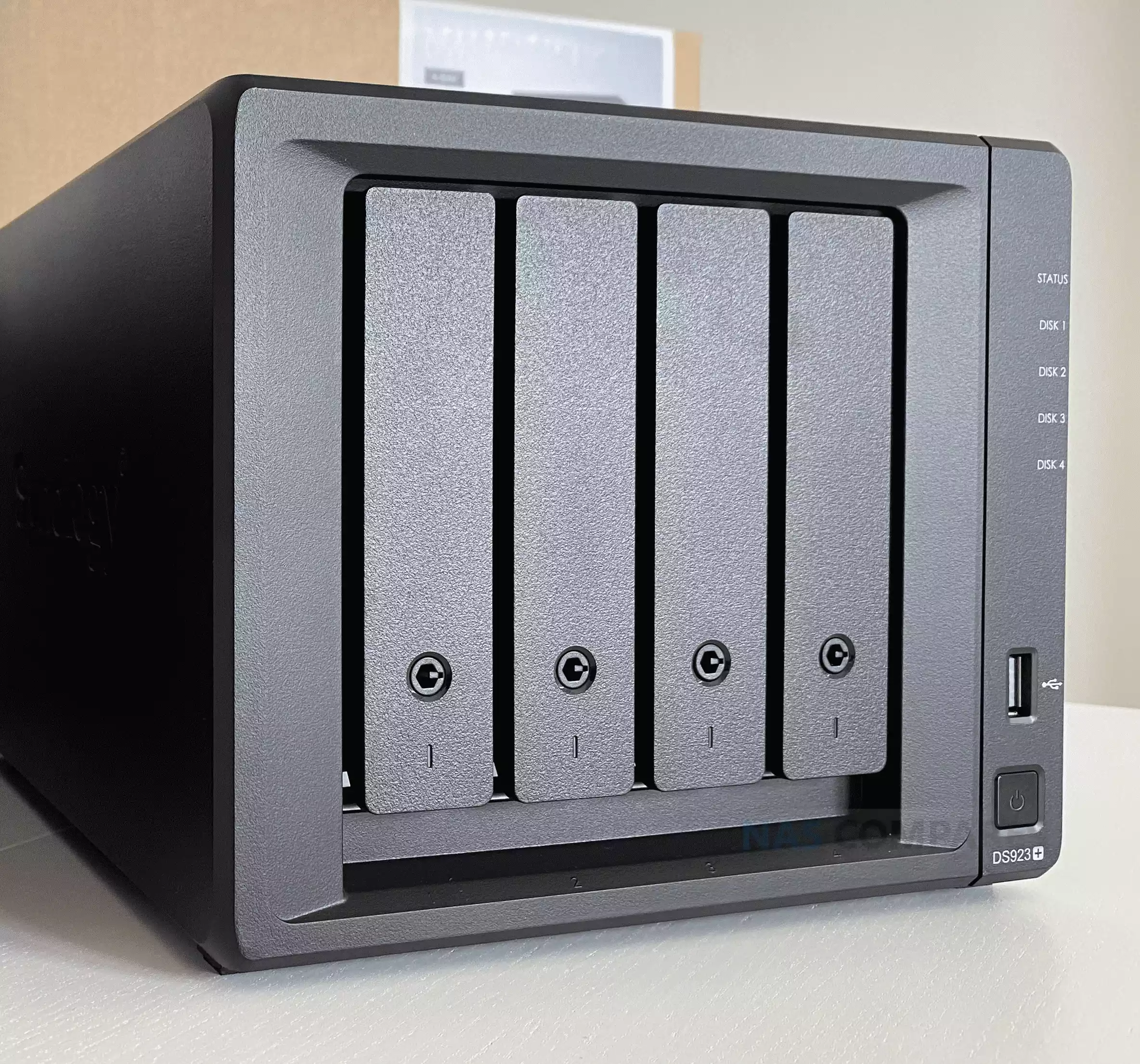 |
|
| Synology DS923+ PROS | Synology DS923+ CONS |
|
|
Need More Help Choosing the right NAS?
Choosing the right data storage solution for your needs can be very intimidating and it’s never too late to ask for help. With options ranging from NAS to DAS, Thunderbolt to SAS and connecting everything up so you can access all your lovely data at the touch of a button can be a lot simpler than you think. If you want some tips, guidance or help with everything from compatibility to suitability of a solution for you, why not drop me a message below and I will get back to you as soon as possible with what you should go for, its suitability and the best place to get it. This service is designed without profit in mind and in order to help you with your data storage needs, so I will try to answer your questions as soon as possible. We pool the comments on this article and the videos that are featured in it to keep all the relevant comments in one place, so take a look and see if your POV is the same as everyone else’s.
📧 SUBSCRIBE TO OUR NEWSLETTER 🔔
🔒 Join Inner Circle
Get an alert every time something gets added to this specific article!
This description contains links to Amazon. These links will take you to some of the products mentioned in today's content. As an Amazon Associate, I earn from qualifying purchases. Visit the NASCompares Deal Finder to find the best place to buy this device in your region, based on Service, Support and Reputation - Just Search for your NAS Drive in the Box Below
Need Advice on Data Storage from an Expert?
Finally, for free advice about your setup, just leave a message in the comments below here at NASCompares.com and we will get back to you. Need Help?
Where possible (and where appropriate) please provide as much information about your requirements, as then I can arrange the best answer and solution to your needs. Do not worry about your e-mail address being required, it will NOT be used in a mailing list and will NOT be used in any way other than to respond to your enquiry.
Need Help?
Where possible (and where appropriate) please provide as much information about your requirements, as then I can arrange the best answer and solution to your needs. Do not worry about your e-mail address being required, it will NOT be used in a mailing list and will NOT be used in any way other than to respond to your enquiry.

|
 |
The BEST NAS of 2026.... ALREADY??? (UnifyDrive UP6)
How Much RAM Do You Need in Your NAS?
A Buyer's Guide to Travel Routers - GET IT RIGHT, FIRST TIME
Jonsbo N6 DIY NAS Case Review
The Best Bits (and Worst Bits) of NAS of 2025!
Minisforum MS-02 Ultra Review
Access content via Patreon or KO-FI





Discover more from NAS Compares
Subscribe to get the latest posts sent to your email.


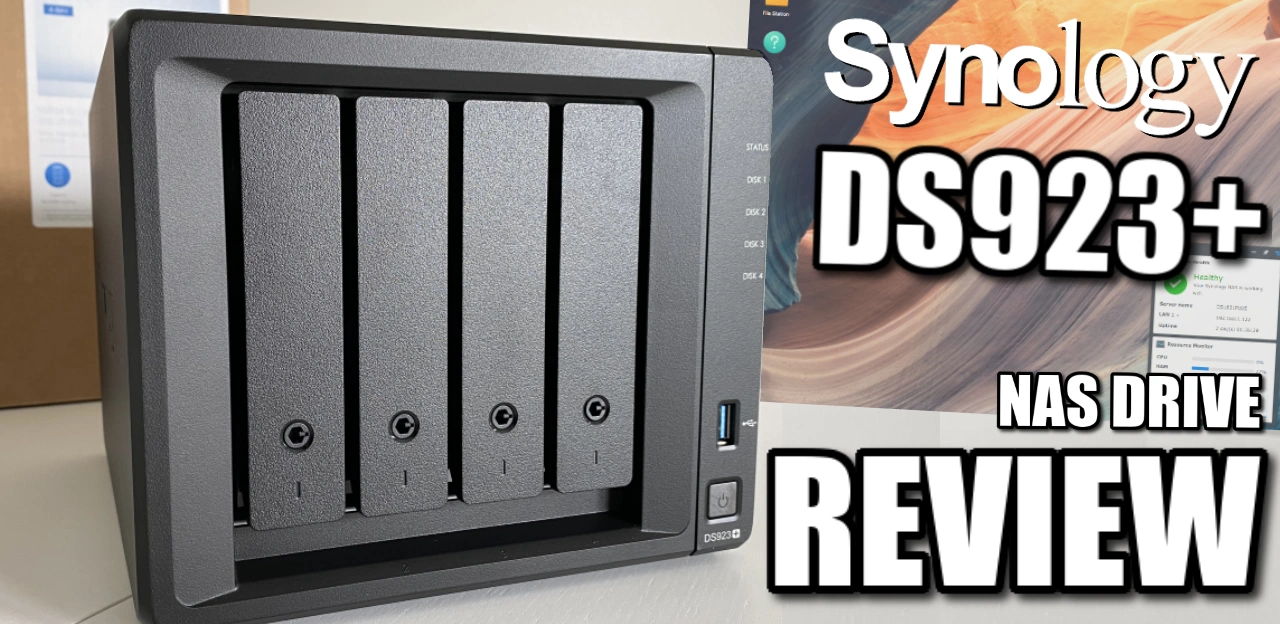




We need nases with intel 13500 cpus in them set to a low power mode to have god tier av1/hevc nas/plex all in one servers
REPLY ON YOUTUBE
Sry Plex is lame, use Jellyfin, is opensource, no online account oder sub. ????
REPLY ON YOUTUBE
I need ecc for zfs. Done.
Plus, I want the power. I can stick a little cheap GPU in of needed and it’d be way more powerful.
REPLY ON YOUTUBE
Question some of the new models do have Intel Celeron. Do those all have the same imbedded graphics as this older model ?
REPLY ON YOUTUBE
Love the video as always. I’m so happy I bought the 920 instead of waiting for the 923. I stream video from my phone frequently so I utilize the transcoding frequently and I love that the 920 handles it with ease.
REPLY ON YOUTUBE
Seems like these comparisons are moot if you just connect any NAS to a Zidoo media player such as the Z9x or Z2000pro to pull the content from your NAS. Those will play anything smoothly, everytime.
REPLY ON YOUTUBE
I do not have much NAS knowledge. I want to put 18Tb video on a NAS. 80 percent 1080p. The rest is 4k and this will become more in the future.
What would you guys buy ? A 923+ or a 1621+ ? Or a different NAS ?
REPLY ON YOUTUBE
I’ve been waffling back and forth between these two, pretty much at some point I won’t be able to find a DS920+ and will be forced to buy a DS923+! haha
REPLY ON YOUTUBE
I still kinda want one of these.
REPLY ON YOUTUBE
I still kinda want one of these.
REPLY ON YOUTUBE
where can I configure and buy one of these put together in the US?
REPLY ON YOUTUBE
where can I configure and buy one of these put together in the US?
REPLY ON YOUTUBE
Hi, I put in my DS923 2x4TB for private files, 8TB for Plex and Emby, SSD for VM…and 256GB for cashe. I just want to say that everything is working great. At first I put OpenVPN and run Plex and it was OK. Sometime it has little of lag …but today I install Emby and reallized that Emby is working much faster than Plex. I do not know what is going on but difference is significal. I run most of movies and shows in 1080o and that is OK for me. I am testing with Emby all day with or without OpenVPN and it is working great. I can say now that I am really satisfied. Synology DS 923 is very good product…. for media, file backup and many, many things. Best regards.
REPLY ON YOUTUBE
Man I haven’t watched your videos in a while and I swear you talk even faster now. It’s almost incomprehensible at times especially if you get excited. I don’t know are you on a time crunch or something? Or do you film these close to dinner time and you want to whiz through so you can eat?
REPLY ON YOUTUBE
bla bla bla, no tests no comparison, zero useful info
REPLY ON YOUTUBE
I just purchased the 923+ last weekend… but it’s just as a hyperbackup vault. Keeping my 1821+ as my main plex server. Wanted the qnap but as only recently moved from self-made NAS with hardware RAID cards, stayed in the ecosystem for now (it was SHR that made me go Synology rather than QNAP/Truenas ZFS)
REPLY ON YOUTUBE
I was going to buy it (I made the order and canceled it few hours later) until I discovered the new “HD compatibility list policy” and how my two WD RED that are compatible in my old Synology NAS are not in the list anymore. No more Synology products until they revert this stupid policy and the path that their are taking with these actions. Good way to ruin the reputation of a good company.
REPLY ON YOUTUBE
Seaguls playing with your lights now?
REPLY ON YOUTUBE
I don’t understand why you would not want to optimise your CPU performance with SMT. It’s basically just saying you’re happy to have your CPU sitting idle instead of working, for a slight improvement on task completion times.
REPLY ON YOUTUBE
The DS923+ with the 10Gbe upgrade is a DS1621+ with $50 10Gbe PCI-E card in price. No way its a good deal.
If they made the 10Gbe card around $80-100, it would make sense. But its $240 CAD, they are OUT OF THEIR F%CKING MINDS at Synology.
REPLY ON YOUTUBE
I have followed you for a long long time, and i have been running truenas/freenas and now i wanted to switch to a smaller box, for a apartment homelab.
I got the 923+ becuase of its ryzen processor, more importnat for the pcie lanes it offers and for ecc ram.
While it seems that the market is big and there are a lot of choices, there really arent many for a 4 bay nas, there are the qnap 464, terramaster whater that have the celeron cpu and nvme that runs at x1 .
The only other variant is the qnap 473a that has a better cpu and faster network + ecc memory , but it’s much more expensive.
So for that the ds923+ seems to be my choice.
Please continue with your outstanding work !
REPLY ON YOUTUBE
I’ve been waffling between the 923+ and the 423+. I didn’t really need the transcoding so the 100 US Dollar difference was decision factor. However, March 31, 2023 both Amazon and B&H Photo dropped the price for the 923+ so it is 10 US Dollar more than the 423+. That made the decision, order placed — using your link. Hopefully that worked.
REPLY ON YOUTUBE
Completely agree with your colleague (Eddy). I have a DS-918+ and have been looking to buy a second device.
However I am not buying a DS-923+ due to the lack of integrated GPU, and 10GbE doesn’t appeal to me as I can’t take advantage of it at home (not cost-effective to upgrade my home network devices to 10GbE).
Unfortunately there seems to be no other comparable option from Synology available at the moment, and any old-stock DS-920+ (and even DS-918+ which I’d still buy) is going for thousands of dollars. ????
REPLY ON YOUTUBE
I think a company which regularly updates its product every 3 years doesn’t make a solid lasting product
REPLY ON YOUTUBE
If Synology introduced nvme storage pools capabilities, would you recommend a data redundancy/fail over?
REPLY ON YOUTUBE
My ds918+ just broke – should i buy this one and can it migrate my disks?
REPLY ON YOUTUBE
I think I bought my last Synology NAS last summer. The sheer wisdom of Synology to not accept other manufacturer’s nvme drives and to not support 2g5 or 5 Gbps as standard is unacceptable. It’s a solid OS , I’m using it since my first ds-101. I’m feeling a bit sad to know that I have to switch. I just have to.
I love the attention of you for the streaming aspects like Plex support. I think you were way to kind on this 923+, though. Air flow , ECC etc don’t make up for the short comings.
Clicked the bells and I keep following you. Thanks.
REPLY ON YOUTUBE
Hello, I’m choosing between these two for mostly PLEX and CCTV (6 x 8mp cameras recording / reviewing) – does GPU vital for my activities or I can go to 923+ without worrying about these main activities?
REPLY ON YOUTUBE
I am thinking about buying one of these and this Video helped me. Unfortunalley I am buying from a smaller companie in Germany.
REPLY ON YOUTUBE
Why can’t Synology get with the embedded graphics program! If QNAP interface and software was more user friendly. Synology would really have problems.
REPLY ON YOUTUBE
Hey guys – really good video. I really researched this topic a lot and decided against the 923+ or 723+ due to dual core and no embedded graphics. I will tell you though, the the 1500B Ryzen in the RS1221+ is a beast. It is by far the fastest NAS I have. My RS422+ has the Ryzen 1600 in it and I’m not super impressed. Most home users are not going to benefit from 10GBE yet because everything else in the house runs 1GBE or less. I’m sticking with the DS920+, DS720+, and RS1221+ for now and skipping the 23+ series. I think Synology really let us down on this one. Also, the hard drive selection on these from the QVL is getting stupid for something that crosses between home and business NAS for the home user who wants more power.
REPLY ON YOUTUBE
“Giant BBC” eh?
REPLY ON YOUTUBE
i feel like 923+ is actually a downgrade, that 2019 intel processor is still more powerful than this amd r1600. also no hardware video decoding….923+ users will be forced to use synology proprietary hardware………..i will hold on to my 920+ without any chance to upgrade at least until sinology REALLY offers a worthy upgrade!
REPLY ON YOUTUBE
I need a simple answer, i’m a video editor and i’m going to use this as mainly archieval purposes. But in some cases i may edit videos on it too. Which one would you recommend me?
REPLY ON YOUTUBE
I just purchased a 723+ and a pair of 12TB drives. Did I make a mistake? What would you purchase instead, staying in the Synology family, DSM is the requirement. I am not going to use Plex ever, It will be mostly used for personal cloud and Synology Photos for local management of my family’s photos’ and videos.
REPLY ON YOUTUBE
Coming from a DS216J either of these two units will be a welcome upgrade. But even as a “home user”, I find that 10Gb network port compelling. I have plans on upgrading my switch to 10Gb to accommodate the 2.5Gb ports on my next pc upgrades later this year. I work from home now and remote access and speed of file transfers is just one of the needs. I do not use Plex, I use Synology Video Station for my home videos. My pc’s do all the transcoding I need. Last year I upgraded my PFSense router from the old dual core celeron to a old AMD E315 dual core APU. It uses DDR3 and I have 4GB ram. It uses 10W more than the celeron (35w vs.25w) but it never gets saturated with multiple streams downloading. I want to use more of the apps available on the NAS but that DS216J at 1ghz and with 512MB just won’t do. It is mostly a file and backup location. I need more HD space and trying to decide between another 2 bay or just get the 4 bay with 10Gb nic and call it a day. Still trying to decide if I need the NVME slots for storage or just use for caching to increase file transfer speeds. What do you guys think?
REPLY ON YOUTUBE
I was going to buy this as my first NAS as I run a small electrical business and also run a PLEX server with only a handful (around 40 titles) of 1080P MKV files.
I use my laptop for my business use but, as my business and client base are expanding, I’m finding I’m maxing the storage capacity of my laptop which now runs like an old Ford Cortina where it once ran like a Ferrari.
My current PLEX server is an Nvidia Shield (2017) so I guess I could use that to process any transcoding etc etc.
I would use 3 x 6TB Toshiba M300’s in a RIAD1 configuration which I feel would be ample space for at least another 5 years or so.
I do plan to create more MKV files but only in 1080p although I do own an LG C2 OLED so 4k is do-able….
Any thoughts??
REPLY ON YOUTUBE
Lol one of the first real tech reviews I’ve seen. Giving a real review with real pros and cons not “fake positive cons” really help solidify the information as being useful. Great job
REPLY ON YOUTUBE
Just upgraded from a DS1812+ recently and ended up with DS920+ instead of the 923+ purely because Synology opted to use an iGP-less chip for the new generation. There are ryzen embedded chips with igp. So disappointed with Synology for cutting out the igp in their new prosumer models.
REPLY ON YOUTUBE
can you use NVME as a volume drive
REPLY ON YOUTUBE
Features important for me:
– Immutability
-Object Store
– Scale out / Web Scale
– 10/25Gb Support
These are all features that are requred for large scale Backup / Archive, we have them using other very expensive enterprise solutions, but as an entry level system for medium size clients would be cool.
REPLY ON YOUTUBE
Something that I don’t think has been mentioned is physically transferring HDDs from an older Intel NAS to the DS923+. I believe you could transfer drives from, say, a DS918+ to a DS920+, but will drives from a 918 be accepted in the 923 considering it’s a Ryzen CPU?
REPLY ON YOUTUBE
I am a Sports photographer, and I’m gathering more and more external drives as time passes, so it’s time to go NAS. Which one would be the best for photographers? Just to put the files, and have security on it? I spend around 6/8 TB per year. Using 2021 27’’ IMac. I need fast reading as I work the photos inside the external drive not in the computer main drive. Cheers. Happy new year
REPLY ON YOUTUBE
synology will lost their market
REPLY ON YOUTUBE
who is in this days playing videos from this… i mean i also have some there but how often do i watch something..? so defenetly the 923… but my 916+ will be enough for the few files the 5 users passing around..
REPLY ON YOUTUBE
Looking to upgrade my NAS, but I don’t know man. I think I’m done with Synology. They just seem underpowered and overpriced these days. They have a bunch of models, but none seems to be a good value anymore. At least for me.
REPLY ON YOUTUBE
It’s a travesty they went with AMD over Intel here. Big mistake
REPLY ON YOUTUBE
Thanks
REPLY ON YOUTUBE
According to cpu-monkey and Geekbench 5 the R1600 is even slower than the J4125 in multi-core benchmark. That makes sense since hyperthreading / SMT can not make up for real cores. Also considering the high power consumption, I think it’s the wrong choice for this kind of device.
REPLY ON YOUTUBE
That was very helpful, thank you! I’m looking for a NAS that will enable me to do video intensive video editing of 4k h264 files. I will do that on 2 macs (imacPro 2017 and MacStudio 2022). So I assume 10GbE is a must have for a NAS. I don’t need all that much storage space because I archive most of the stuff that I finished working on.
Do you think the DS923+ is the way to go, or would you recommend something else?
Any help is greatly appreciated. For a layman all the NAS options seem a bit overwhelming.
REPLY ON YOUTUBE
Sorry but to me the older DS920+ beats the newer DS923+ hands down. You belittled HEVC (a.k.a. h.265), but that is the format used in most high-end surveillance cameras these days. We are a commercial dairy goat farm, and we have a good number of PTZ video dome cameras in all our stalls to monitor our livestock when they are in labor (goats often need assistance when giving birth). Not having built-in video processing is a deal-breaker for us, so the DS923+ would be an expensive step backward for us.
I really like the excellent information that you provide on your channel, but I must confess that in this particular video I was rather turned off by your emotional and seemingly biased approach toward the AMD processor.
REPLY ON YOUTUBE
Synology could have used 1605 chip with integrated graphics and had AMD hardware transcoding for a couple of extra dollars, instead crippled the DS21,22,23+ models for plex
REPLY ON YOUTUBE
Maybe I’m missing something? I run a synology nas and use the infuse app for apple on all my apple 4K’s for media streaming. What am I missing out on not running plex? I’m guessing all the magic is happening inside the phone or Apple TV because my nas or media never lags when watching 4K hdr10 or Dolby vision title. Seems like so manny people worry about plex performance is this just because they don’t use Apple devices? I tried plex it was pretty bad at stream when the nas needed to decode or whatever.
REPLY ON YOUTUBE
My dude, another spot on video – can guarantee you have helped more than one person make an informed decision.
I have been holding and holding with my 214play (bleh) to see what XXX23 brings and it looks like XXX20+ is still the answer for the prosumer/transcode user.
Perfect level of information and impartiality (I’d call the new releases a hot steaming pile, but that’s just for my use case) – lets hope they’re not gearing up for a quad core DS923+Play++GOTYE+Platinum+++++ with an onboard graphics!
REPLY ON YOUTUBE
Asustor AS6704T. And Qnap has some alternatives as well.
….is there an alternative new nas with embedded graphics?
REPLY ON YOUTUBE
Looks like Synology have discontinued the 920+ for some reason (no longer on their website) so looks like no option but to purchase 923+ now for the normal person maybe have to find another brand instead (was looking for 920+ on a Black Friday deal but seems no one really offering it. Oh well time for re-think on what to do now
REPLY ON YOUTUBE
So how will the 923+ handle surveillance station without the embedded GPU? 6 x 4K cameras for example. Is this going to be able to record and handle remote viewing on i devices? Better or worse than the 920+? I don’t have or want plex, just curious about the surveillance video aspects.
REPLY ON YOUTUBE
This is not a review but a sales pitch. Stick to FACTs and not hopes or suppostions. Very disappointing ‘review’, with little mention of the Synology lock in of added gear to make it work. No 2.5 or 10G network as standard. What a joke.
REPLY ON YOUTUBE
do we know when the DS 923+ is available in the UK?
great timing as was looking at getting either the ds1522+ or ds1621+ but this looks a better solution for me
It might take a week for the stock to arrive.
Thanks Eddie
Box have some now, but nowhere else, like you say hopefully some more appearing in a week, really like the 4-slot solution, shame there is not an earlier 4-slot version that also has pcie solution like the DS1621+
Just got myself 920+ after this video
REPLY ON YOUTUBE
Hu guys, Your comparison is exactly what I was looking for ????. Many thanks! As I am a private user I tend to decide for the DS920+ because the DS923+ seems to be more geared towards enterprise use. I guess I won’t feel any performance disadvantage of the Celeron vs. the Ryzen processor but I might feel the difference in power consumption.
Interestingly, the price development for the two servers is somehow counter-intuitive. While the DS923+ is already available for € 610 in Germany (coming from € 620), the price for the DS920+ has gone up from € 922 to € 947 within the last days. So the price difference is only € 63. Although I could afford this little difference I am still inclined to go for the old model.
What are your thoughts?
REPLY ON YOUTUBE
I was waiting for this to replace my aging DS412 which cannot run VM’s or Dockers which I need to install Home Assistant (home automation). However, a 2 core CPU does not mesh well with virtualization (I agree that threads are not cores …). The lack of a 2.5 GB ethernet port and the higher power use are just the final nails in the coffin for me, I’ll be skipping this model and hang on to my DS412 for the moment …
REPLY ON YOUTUBE
So, not only is it missing 2.5gbps, and has a proprietary insert card for 10/5/2.5 wich will cost closer to 100-150 euro, it requires their OWN EXPENSIVE DRIVES.
Im not expecting the “base” ds923 (none-plus) to support essential features, like the expansion card, virtualisation, ram upgrading.
They are going to force people who have a 920+ or similar to switch to another manufacturer all together.
Synology is greedy and will loose alot of favor in the home user department, wich in long term will hurt them as people dont get used to their software/hardware early.
REPLY ON YOUTUBE
920+ for me !! , I some times I do not understand Synology ?! just upgrade the Intel Cpu with 4k support and you have ours wallets !!
REPLY ON YOUTUBE
I dont really like these 5 reasons videos. Just tell me what is good and what not.
REPLY ON YOUTUBE
I dont really like these 5 reasons videos. Just tell me what is good and what not.
REPLY ON YOUTUBE
*Important* Interested in the software that the Synology DS923+ NAS Arrives with? Check out my MASSIVE Synology DSM 7.1 Software Review HERE – https://youtu.be/SqFa0WyxGJc
REPLY ON YOUTUBE
*Update, Synology DSM has been updated to DSM 7.1. So, check out my MASSIVE Synology DSM 7.1 Software Review HERE – https://youtu.be/SqFa0WyxGJc *
REPLY ON YOUTUBE
*Update, Synology DSM has been updated to DSM 7.1. So, check out my MASSIVE Synology DSM 7.1 Software Review HERE – https://youtu.be/SqFa0WyxGJc *
REPLY ON YOUTUBE
Thks, NAS Nerds
REPLY ON YOUTUBE
DS920+>DS923+
because AMD CPU is shit
fuck GigaLan
REPLY ON YOUTUBE
This „before you buy“ helped me alot. Conclusion for me as multimedia guy: wait and hope that Synology will release a DS with integrated GPU or looking to Qnap and hope that they make their NAS SW secure regarding Cyberattacks… But how long do I have to continue waiting for that …. Maybe another two years ????????
REPLY ON YOUTUBE
AMD = shit
REPLY ON YOUTUBE
According to the spec sheet the NVMe SSDs can be used for “additional storage pools.”
The Synology DS923+ is a capable 4-bay NAS solution that can be adjusted and expanded as your needs change, with optional support for up to nine drives, faster networking, and NVMe SSDs for caching or additional storage pools. Powered by Synology DiskStation Manager (DSM), it offers a flexible all-in-one solution for data sharing, synchronization, backup, and surveillance.
REPLY ON YOUTUBE
Will it support Raid F1? It seems not.
REPLY ON YOUTUBE
Thanks for the warning not to buy
REPLY ON YOUTUBE
I assume as I use the latest 2022 Apple 4K TV I don’t need to worry about transcoding by the NAS
REPLY ON YOUTUBE
the 920+ has some stuttering during playback. it wil just freeze for a tenth of a second during playback (like the spiderman-scene at 8:40 when they’re talking, 8:49 with the large screen, at 9:00 during the fade-in). That would be unplayable for me because it’s very noticable and annoying. Could it be that the settings were wrong for playback in plex? That it’s playing back in 24p instead of 23,997p and that’s why you get stuttering?
REPLY ON YOUTUBE
This thing should be $249 give the low powered CPU, 1gbe ports.
REPLY ON YOUTUBE
Thanks for the video. Everything about this device tells me to change to QNAP after 15 years of using only Synology. The only thing that still has me on the fence is that it will not be as compatible using my old Synology for backing up from my new NAS.
Using it mainly for media the AMD processor is a big minus. I’d consider the 920+ which keeps my new CAT7e network unused. QNAP doesn’t have DSM. Dilemma.
REPLY ON YOUTUBE
Came to see what underpowered CPU Synology put in their NAS for 2023. Wasn’t disappointed.
REPLY ON YOUTUBE
DS923+ ……. Garbage
REPLY ON YOUTUBE
Out of the box, this is mostly a downgrade or level with the prior version. Worse power efficiency and limited support for third party drives are the ones that affect me, and it grates that I have to pay relatively a lot extra for up-to-date networking. I just want a big, simple, super fast storage engine on the network for two photo / video editors. I could make the DS923+ work, but I’m going to take a hard look at QNAP and others. I love my DS218j, which taught me the joys of NAS. But Synology just seems a bit hostile to its customers.
REPLY ON YOUTUBE
I’m glad instead of doing a long form 30-40 minute review you did a much shorter 33 minute video ????. Haha I’m just messing around, this was really helpful. I’m on the fence with the ds923+. I am a heavy Plex user and some family members use my current server with transcoding outside my home, but I use an Apple TV 4K and mostly do direct play myself. I have fast upload speeds, so maybe since I’ll be able to connect this over Ethernet, it’ll be fast enough for any family members to also direct play. The overall faster CPU and potentially faster Ethernet ports seem like nice upgrades over the 920+. Decisions, decisions. Thanks again for the info! I’ve been following your videos over the last couple of months as I’ve been trying to narrow down my choices for a new, first NAS.
REPLY ON YOUTUBE
Short answer is no. This NAS is a fine file server, but way over priced. For less money you can get a Terra or Asustor and get the same performance. If you wanted to go prosumer, QNAP really is the only way to go. I went with 453E and it works extremely well and is just amazing in all that it can do. Sadly Synology is going very cheap to bump bottom line and is focusing on file serving.
REPLY ON YOUTUBE
I bought the Asustor Lokerstor Gen 2 4 bay and it’s really fast. I even enabled to generate frames in Plex and it did that flawlessly while downloading data with download manager and watching a movie.
REPLY ON YOUTUBE
Thank you for saving people from big purchasing mistakes! When I saw it didn’t have an Intel CPU, I thought about Plex Transcoding performance immediately. I would like to see benchmark comparison with the DS920+ for Plex performance…please ????
REPLY ON YOUTUBE
Looking to upgrade my 1515+. Looking at 1522+ or 1621+. Is the 1621+ worth the extra $200 (cdn)?
REPLY ON YOUTUBE
No Plex no love. Simple as that.
REPLY ON YOUTUBE
Your audio is late to the party. Do you do the clapping before recording?
REPLY ON YOUTUBE
For Plex users that still need to transcode I think the best option would be just to use the DS923+ as a file server . Pick up an 8th gen or newer intel NUC for transcoding duties and point the folder share to the DS923+ where your Plex media would be stored.
REPLY ON YOUTUBE
So NVME as storage would be available at 920+ or just at 923+? Bit confused here cause it could be the game changer.
REPLY ON YOUTUBE
hmmm, i just ordered the 920+ this morning, damn will cancel my order then?
REPLY ON YOUTUBE
Can I have a TLDW? Buy 923 or 920? 923 has ECC, more energy consumption and faster clock speed. So 920 right? For having more dedicated cores and more importantly that sweeet sweet transcoding action
Edit: I cant wait for the upgraded models for 1622+ 1622xs+. Would it be alright to expect them to release these in a years time or are these already new?
REPLY ON YOUTUBE
Great content, thanks for all the input
REPLY ON YOUTUBE
Noticed this on Synology’s website on the DS923+ product page “Synology SNV3400 series M.2 NVMe SSD drives can be installed through the built-in M.2 slots to enable SSD caching or create SSD storage pools”. This does look like Synology will enable NVME will be allowed for storage pools.
REPLY ON YOUTUBE
Short answer: No. You should NOT buy the 923+. This is def a skip generation.
REPLY ON YOUTUBE
shame I bought the 920+ few months ago… well guess i’ll start looking to upgrade to the 5-bay version of this
REPLY ON YOUTUBE
Thank you very much for your video and your invested efforts!
Could you tell me, with how many tablets/mobile phones could you use to access and watch videos on the NAS from the Internet?
REPLY ON YOUTUBE
The Synology DS923+ NAS Review is now LIVE! Find it here – https://nascompares.com/2022/11/16/synology-ds923-nas-review/
Find Blackvoid’s review of the DS923+ NAS here – https://www.blackvoid.club/synology-ds923-review/
REPLY ON YOUTUBE
The Synology DS923+ NAS Review is now LIVE! Find it here – https://nascompares.com/2022/11/16/synology-ds923-nas-review/
REPLY ON YOUTUBE
The Synology DS923+ NAS Review is now LIVE! Find it here – https://nascompares.com/2022/11/16/synology-ds923-nas-review/
REPLY ON YOUTUBE
On the RAM front, I’ve been running my 920+ with 20GB RAM (Timetec 16GB stick installed) for months without an issue. Other things will be a bottleneck before the RAM for me. When I had just the basic 4GB, RAM was being fully utilised for some operations but 20GB I’ve never seen pushed. At least when I’ve checked.
REPLY ON YOUTUBE
Will pass on this and wait and see if we get a DS1524 with better hardware
REPLY ON YOUTUBE
Tip!: Hardware-accelerated streaming is a premium feature and requires an active Plex Pass subscription.
REPLY ON YOUTUBE
#920+Forever #Team920+
REPLY ON YOUTUBE
Best description of Plex ever! ????
REPLY ON YOUTUBE
You can already turn the NVMEs into a storage pool. Pretty straightforward as RAID1, and a gamechanger for putting things like Plex or Docker directly on that NVME storage pool. Blazing fast!
REPLY ON YOUTUBE
Unfortunately for all multimedia guys Synology took the opposite path, for enterprise companies it is ok but not for the regular consumers like me.
REPLY ON YOUTUBE
Always, thank you for great video sharing. I just bought my 920+ last week, upgrade from ds214play . After compare and found the new features offer in 923+ is just not what really need the wait.
REPLY ON YOUTUBE
Eddie was right on the button! this is a low level business NAS, rather than a Mid/high level SOHO/Prosumer user! Big pass for me. I so much wanted to upgrade next year! Not happening for me now with this model, I’ll stick with my 918 for now, no way going to Qnap (just because of DSM, but for how much longer?).
REPLY ON YOUTUBE
I just bought my ds920+ two weeks ago to avoid ds923+ and I am so happy ????
Do you expect some new ds123j? for remote backups
REPLY ON YOUTUBE
I absolutely LOVE my 920+. I have had zero problems for 3 years now.
REPLY ON YOUTUBE
Ah so the local Seagulls are Mac users?
REPLY ON YOUTUBE
macOS = Carbon Copy Cloner! Bootable backups to RAID1 eSATA external device. Data – ‘cold’ backed up to NAS / remote NAS / SynologY C2 Cloud. 3-2-1 backup.
REPLY ON YOUTUBE
Please link the LAN Card. ????
REPLY ON YOUTUBE
Where is DVB-C support? this is going backwards…
REPLY ON YOUTUBE
Luka could use a proper mic. I found it tough to understand him most of the time with that iphone earbud mic. Very muffled.
REPLY ON YOUTUBE
Robbie, first it was Rooter vs Rowter. And now you’ve thrown a spanner ( that’s wrench to the Rowter crowd ) into the works with Beeta vs Bayta. And next, will you hate Shit hawks or Shite hawks ? I can’t take it any more. I’m going to head down to the local for a poynt and maybe stay for the carvery.
REPLY ON YOUTUBE
ds1621+ vs ds1522+
Things that important for me:
– surveillance station
– google photo replacement.
– ecc memory
– maybe iscsi/file storage
– full size pci slot for sfp+ is a bonus but not the main concern
Which cpu is better for this scenario?
REPLY ON YOUTUBE
Ok. @ about 5:12 or maybe 5:13, 5:14, it sounds like someone FARTED!!! ????????????. Listen to it. Someone let a stink bomb out of their ass????. And don’t say it was seagulls. ???? too funny. Anyway keep up the great work. I am a server nut. I have 4. Though I retired 1 of them.
REPLY ON YOUTUBE
Wow, so Plex users are basically not getting an upgrade this cycle. In light of that, please do a “2023 Plex Server Which Should You Buy”
REPLY ON YOUTUBE
I have to say I found Luca audio quite muffled compared to yours. It was tricky to understand him in parts.
REPLY ON YOUTUBE
Also – for those who are wondering where Eddie is… HE is the one sending messages (the notification noises) later in the video that I am desperately scrambling to disable (and failing). He says Hi btw…
REPLY ON YOUTUBE
No ds1823+ news?
REPLY ON YOUTUBE
*IMPORTANT* – Few disclaimers on this vid! First off, Apologies for the sound de-sync in 3 areas(especially in the first 15 seconds), this was largely unavoidable due to the constraints of recording the zoom audio and not using a 3rd party recorder. Next, We mention this several times, but do not be surprised if several of the features covered are eventually rolled out as features independent of DSM 7.2. The last point, sorry this vid has taken longer than it should (Synology 2023 and Beyond was 2 weeks ago!) but I judged coverage of the new Synology DS923+ that emerged at the same time as the thing you guys would want to know more about first, so I prioritized that. Hope you like this long-form discussion and mashup of NASCompares and Blackvoid. If yes, we hope to do more in future!
REPLY ON YOUTUBE
I’m sorry but this videos is just misinformed. The integrated graphics are not used for transcoding. There are dedicated chips for this purpose. The memory is a huge boon and the base model wattage is 15 not 25. They could have stuck with Celeron but the amd isn’t bad and was specifically created for embedded unlike the celeron.
I think it’s a smart move
REPLY ON YOUTUBE
Great video ????
Was wondering if you have a link for that video trailer which you showed last? I believe it was a Hevc 4k
60mb/s ?
Would like to DL it and try some tests on my end !
Cheers
REPLY ON YOUTUBE
Need Help!
My turn finally to buy a NAS and money isn’t an issue.
I edit 4k multi cam vids all day long and need to work off a NAS that has caching etc. I will need raid to back up work just in case of storage failures. My vid and clips and data are at the moment at around 15T so want a system that can handle that, back it up, and extract the data whenever I need with fast speed.
Again I want the best, something that will last years and not something that will be outdated any time soon.
Speed is the key for me though.
Thanks
REPLY ON YOUTUBE
Jesus Christ the disinformed rage here. ????
Where did you find this guy? a 2006 Best Buy?
REPLY ON YOUTUBE
Changed from. 1817+ to 1821+ resulted into 3.5gbit to nearly 7gbit performance of a single 10gbe copy from my pc
Same Intel card, same hdds… Just the Nas changed.. Thanks ryzen…
REPLY ON YOUTUBE
*Intel Celeron J4125* : _Release Date Q4 2019,_ 4-Core CPU with Integrated Graphics (Synology 2020 NASes)
*AMD R1600* : _Release Date Q2 2019,_ 2-Core CPU with no Integrated Graphics (Synology 2023 NASes) Progress ? ????????????
REPLY ON YOUTUBE
*Intel Celeron J4125* : _Release Date Q4 2019,_ 4-Core CPU with Integrated Graphics (Synology 2020 NASes)
*AMD R1600* : _Release Date Q2 2019,_ 2-Core CPU with no Integrated Graphics (Synology 2023 NASes) Progress ? ????????????
REPLY ON YOUTUBE
Thank you for this video. It was a big help in making my decision to buy the DS920+. It’s a great NAS and I am so happy I bought it.
REPLY ON YOUTUBE
Far more important than the CPU is the lack of 2.5Gbe. This model is DoA due to Synologys failed obsession with 1Gbe speeds. I’ll be sticking with my Asustor with superior speeds until Synology pulls their thumb out and gets with the program.
REPLY ON YOUTUBE
Oooooooooooh;
Synology DS1522+ NAS Video Station Testing 4K & 1080p https://www.youtube.com/watch?v=ZLTVjScmU-w
REPLY ON YOUTUBE
I think the biggest advantage the 923 has, which I didn’t hear discussed, is 3 additional years of DSM updates.
REPLY ON YOUTUBE
i’ve watched your other vidoes of 4k comparasions but these NAS are not able to play HIGH BITRATE 4k content. So if the intel CPU is powefull enough then what is creating the bottleneck? because streaming is mostly IO bound process (as contracy to cpu bound process which requite more processing power) so processorer can’t be bottleneck. what are everyone thought on this?
REPLY ON YOUTUBE
Thanks for the great content. I’m buying a NAS, and I want Synology. I’m torn between 920+ and 923+. I dont need 4k transcoding but will the 923 keep up with regular 1080p video? And with NVR? Can I see the video from my IP cameras? There is a mention in your video to AI in photos, does it need GPU? 10 Gbe support is not essencial to me, I would choose the 920+, but I’m afraid that the support for some DSM features will end 2 years before? Kind Regards
REPLY ON YOUTUBE
IGP missing is not good
REPLY ON YOUTUBE
I am looking at getting a new Synology NAS to replace the current one I have. It’s going to be in a home environment where media is high priority and data storage/sharing is 2nd. Seeing that the new NAS supports more than 8GB RAM is something I like, I am torn by not having the video transcoding of the DS920+ for more memory. What are you thoughts?
REPLY ON YOUTUBE
Im going Qnap next time. Syno is just doing everything wrong lately
REPLY ON YOUTUBE
Love seeing strong, well thought out, opposing opinions. So much better than watching two people sit there and agree with each other.
I want the best of both worlds. Is there a Synology with integrated graphics that supports 10Gbe?
REPLY ON YOUTUBE
Look asustor lorckerstor 4 gen 2
REPLY ON YOUTUBE
I’d like you to put together the top 3 Synology devices for multimedia use at home – think Plex.
REPLY ON YOUTUBE
I have DS920+ Plex server over 60TeraBytes videos. Works great….until you want 4K movies with subtitles and things start to break down as the server tries to transcode. The DS920+ just can not handle what is asked of it if it has to do transcoding. As more and more 4K videos are available, it would be nice to have the CPU power to do the work. If you can live without subtitles and just watch the 4K stream, 4K really makes a difference in quality of movie. One Gig ethernet vs 10 Gig ethernet really does not matter in homes since most homes can not get 1 Gig Internet…yet. Most things stream well over Internet from my server like when on vacation or allowing friends to stream off my server…..just not 4K.
REPLY ON YOUTUBE
Please compare with: Asustor Lockerstor 6 Gen2 AS6706T !
REPLY ON YOUTUBE
Didnt get any reaponse under previous video so posting it also here:) If I am fine with paying bit more I might as well not wait for ds923+ and just buy ds1522+? I understand that ds923+ will be less powerful version of ds1522+, right?
REPLY ON YOUTUBE
I am running out of space in my ds918+, so would it be worth getting the ds923+ and stuffing 4x8TB in it AND keeping my ds918, or get a dx517 with 8TB drives? Any news on the dx517 replacement? I don’t really need an extra NAS tbh, so I think I’ve answered my own question.
REPLY ON YOUTUBE
This is a bit tongue in cheek but imagine how a NAS would perform and with ultra low power on Apple M1/2 silicon
REPLY ON YOUTUBE
I have a query, hope you can help. I have a 4 bay nas 412+ with only 2 HDD in it with SHR raid type and DSM 6.
As there are only 2 HDD here, can I upgrade to 2 bay nas and put these 2 HDD there without loosing my data. Will it work. If it works, I will buy a new 2 bay nas, probably 720+. Will appreciate your response. Please advise.
REPLY ON YOUTUBE
Thanks but I’ll buy better QNAP TS-264C-4G
REPLY ON YOUTUBE
Picked up a DS920+ downunder here for 420 AUD (235 GBP) 3 weeks ago, setup and running next day = Bargain. Running without any issues after going from a DS218 to the DS920+. So easy to upgrade, Synology makes it so easy !!
REPLY ON YOUTUBE
Have a 920+ and mainly use it for Plex server. Maybe not just HEVC but there are other things which trigger transcoding. On a Roku client, the PGS subtitles trigger transcoding. It made me move to FireTV Max sticks instead of Roku. Ultimately, a Shield PRO is required for clients if you want it all. (FireTV does not support DTS and a lot of older BluRay have DTS only). Happy with my 920+ overall (the small amount of BluRay with DTS only aside).
REPLY ON YOUTUBE
i am a synology fan but the continual 1gbe ports is getting really old. Its rediculous they will not offer built in 2.5/5 or 10g ethernet
REPLY ON YOUTUBE
Yes, we like AMD Ryzen. No, we don’t like the fact Synology choose one without GPU and HW transcoding.
REPLY ON YOUTUBE
I can ask you a special favor, can you tell me how good are the NAS ASUSTOR and TERRA MASTER brands?
Which is better for companies?
Thank you very much for your help.
Your videos are excellent. They help me a lot in my work.
Greetings from Quito
REPLY ON YOUTUBE
For me, its a no brainer; I will keep my DS920+ as it has an IGPU
REPLY ON YOUTUBE
According to Synology; SMB multichannel will be a part of DSM 7.2. When/if this happens then even the older units like DS918+, DS920+, DS718+, DS720+, DS1520+ etc. will be much more useful by double or higher network speed. 1Gbit LAN speeds, which is the limit now, is really the biggest downside for these older units.
REPLY ON YOUTUBE
TS-473 ordered, bye synology
REPLY ON YOUTUBE
According to benchmarks, the single core performance of the 4125 is only marginally less than the R1600. However the multicore performance is around double in the Celeron’s favor. I’m having a hard time seeing how you can claim the AMD chip is better in DSM, let alone at multitasking.
REPLY ON YOUTUBE
Only another 8GB memory for the DS923+ is the price of a NEW NAS :), let alone 32GB, on the DS920+, 8GB Crucial memory is 30 EURs.
REPLY ON YOUTUBE
@NASCompares I’m waiting for the TVS-hX74 series to become available. When is that review coming? ????
REPLY ON YOUTUBE
Why would someone do video editing on the NAS? Why not edit locally and upload? How many people run virtual machines on their NAS? Are people installing a DNS on their NAS?
REPLY ON YOUTUBE
Ds920+ and my new AX6600 is a efficient combo. I just had a little problem with DNS Server app. It did slow down my www loadup.
REPLY ON YOUTUBE
I think too much of the video is about hardware specs. In the end there’s only one thing that matters and that is what you want to do with your NAS and if you can. So far I haven’t heard a single convincing argument to upgrade to the DS923+.
REPLY ON YOUTUBE
Love my 920+ for home theater and local backups. Add the good things I’m hearing about DSM 7.2 and I won’t be upgrading anytime soon.
REPLY ON YOUTUBE
I’ll be buying whatever is more affordable And supports non synology drives.
I deploy many of these and the 220+s for Active backup.
The CPU isn’t ever a limit on this task.
The only bottle neck I find is disk IO
REPLY ON YOUTUBE
what irks me with the 923+
1. it doees not have 2.5g (yes 10g expansion is great but 2.5g is the baseline in my book for even a 2bay these days).
2. dsm still does not allow the nvme bays to be used for anything but cache. it should be an optional extra drive pair ideal for fast access to tons of tiny files, something that nvme is absolute top at.
2 can be remedied in software if synology so chooses. 1 however is fixed and as such the higher price is a show stopper for me. i do not care for the integrated graphics but if you want me to shell out more coin for the new rig, you need to provide a well rounded system and with the network ports from yesterdecade synology utterly dropped the ball in my book.
REPLY ON YOUTUBE
Love the content chaps!
REPLY ON YOUTUBE
As it sits, without the 10Gbe upgrade, the 923 has nothing to offer for the increased price. Adding the cost of the 10Gbe upgrade makes it too expensive for what you’re getting and you’d be better off looking at QNAP or something else.
REPLY ON YOUTUBE
Thanks for the great content. I am thinking of buying a NAS system and this channel has been very informative. One concern I have regarding the 920+ is future support. I understand that it is compatible with DSM 7 but at what point do you think that Synology will come up with a newer software version that does not run on the 920+?
REPLY ON YOUTUBE
I don’t think transcoding is a big deal,
HEVC is quite widespread, and 1080p video rarely goes beyond about 15Mbit, which hopefully NAS users have as upload speeds by now,
optional 10Gbe is perhaps a bit hit or miss, slower drives won’t saturate it, small files still transfer much slower, and all-SSD 4-bay NAS is not justifiable yet,
I’m waiting for 8-bay successor to DS1821+, if Synology makes it right, I’ll buy it 🙂
REPLY ON YOUTUBE
Well i got a brand new DS920+ sat on my desk just chucked 4x4tb wd red pro drives in ready to venture into the world of nas .
Not sure if i should wait for the 2 x 500gb m.2 s to arrive tomorw an the 4gb extra memory. or crack on now an fit them tomrw.
REPLY ON YOUTUBE
I’ve got a quick question: @5:30 What is an AMD Emb. Ryzen R1600 2-core/4 thread 2.6-3.1Ghz Quad Core Processor? ????
REPLY ON YOUTUBE
For me Synology is dead (it’s dead Jim 🙂 ). The QNAP 4 bay nas solutions entirely overshadow Synology at this point. The integrity of their product tiers to offer what each tier may want, is clearly correct. Synology killed a really great prosumer product tier at the expense of driving bottom line. So for me neither the 923 or 920 make any sense to purchase at this point (That is why I purchased a TS-453E, which I’m extremely happy I did)… They should have just created a new cheap business user tier for this stale junk they are peddling… And then make the 923 more like the 464 or 453E where it belongs.
REPLY ON YOUTUBE
When is DS923 vs Qnap 464 video coming out?
REPLY ON YOUTUBE
The most BLA BLA BLA boring videos on Youtube. Do a review, do test, do measurement.. DO SOMETHING please!!!
REPLY ON YOUTUBE
Hello guys. I’m really confused ???? I want to buy a NAS but what should I buy? Synology? Qnap? What processor? I want to use it as a media player. Most of my video’s are 4K or 4K HDR/Dolby vision. Please some advice? Thank you.
REPLY ON YOUTUBE
I still have my DS918+ and won’t be upgrading anytime soon!
REPLY ON YOUTUBE
37 BC – hilarious
REPLY ON YOUTUBE
Was this video sponsor by Synology? Looks likely!
REPLY ON YOUTUBE
Hmmmm …. AMD is famous for it iGPUs.
???????????Welllllllllllllllllllllllllllllllll why in the heck didn’t Synology just put a AMD CPU with iGPU in their darn home/office NAS???????????? (no entiendo senor 😉
REPLY ON YOUTUBE
Have you cheked out this mini itx, 6 sata ports, 2 nvme and 2.5 gig N6005 motherboard?, perfect for truenas with a pico PSU… available on Ali… NAS Motherboard N5105/N6005 4x Intel i226-V 2.5G Nics Dual M.2 NVMe Six SATA3.0 2*DDR4 HDMI2.0 DP Mini ITX 17x17CM
REPLY ON YOUTUBE
Slightly higher clocked
Dual-core + Hypertheads
Vs
Slightly lower clocked
Quad-core + no Hypertheads
????
REPLY ON YOUTUBE
FIGHT FIGHT FIGHT FIGHT!
REPLY ON YOUTUBE
I ended up buying the 1522+ as I was hopeful it would have a graphics processor but come to find out that it’s not really needed and not a hill to die on to be honest. Better option is the 10GBE (that should have been included) as a future proof option and more ram. If embedded graphics is a must for plex then just buy a NUC or use a old computer for a Plex server. Most if not all formats play on newer devices so transcoding isn’t needed.
REPLY ON YOUTUBE
I think even the seagull behind Ed was totally unimpressed by the argument for AMD. Of course if Synology’s aim is to have a separate range of commercial NAS and a separate range of consumer, media, NAS then fine.
But they should announce their intentions as I guess half their customer base wants Plex and also 1gb Ethernet and has no use for 2.5 gb or non embedded graphics
REPLY ON YOUTUBE
Trying to “both sides” this is a bad look for your credibility as an independent reviewer. Call it like it is – this is a bad move from almost any angle, and the few advancements in the -23 series are things that could have easily been achieved with a newer CPU with integrated graphics. Synology cheaped out because they got a good bulk deal on low end Ryzen chips, and their product lineup is going to suffer for home users for the next few years because of it.
It feels like you’re so committed to Synology because your YT channel relies on them being successful, so you don’t know how to react to bad decisions like this other than to put on a brave face.
REPLY ON YOUTUBE
14:53 really says it all….
We have no issue with AMD powered CPUs if they would have the same or better GPU power which the R1600 has not… APU NAS when?
REPLY ON YOUTUBE
What is the NAS going to be used for? I think with the support of virtual machines and containers, your NAS can also double as your main home server. If that’s what you’re looking for, I’d say go QNAP.
That’s what I did. I bought the QNAP TVS-H1288x. Yes, it is expensive, but it also serves many purposes in my home. I have a Plex server, along with a Windows 11 and Ubuntu VM running, and a few containers to handle various duties in my house. It has 4 2.5Gbe ports, 2 10 Gbe ports, and 2 Thunderbolt 3 ports for any imaginable network needs you might have. I can still add a GPU if I want and I’m currently only using a portion of the machine’s potential. So I won’t be needing to upgrade this H/W anytime soon.
If you just want a NAS, then the CPUs offered by Synology are more than capable of handling the task. I prefer the Synology S/W over QNAP, but Synology needs to up their H/W game to include at least one 10Gbe port on every model they sell. Buying a NAS today with 1Gbe ports is a waste of money, and quite honestly link aggregation does not do the job. I have an old DS1512+ that is over a decade old and still running fine. None of these new 2023 Synology boxes you’ve been discussing offer much more than that old DS1512+ I already have as far as a NAS is concerned.
REPLY ON YOUTUBE
Would it be a possibility that Synology developed a “graphics card” to plug into the pci-e expansion slot? So you could choose between graphics acceleration or 10G adapter.
REPLY ON YOUTUBE
I just have a separate pc that comes on, on demand for when I need to play Plex media. It boots in 10s so it’s fine. I’ve given up on wanting to use a NAS for videos.
REPLY ON YOUTUBE
Had moved to 1621+ last year, i never found losing the gpu cost me anything. My prefered way to watch video is through ds file and native player, both in home and on the go. I don’t had much those extreme high bit rate video file outside of a select few of collections. Those are wast of storage and money in my opinion.
REPLY ON YOUTUBE
This whole apparent myth about threads = cores is BS. Even at slightly higher clock speeds, the R will underperform vs. the Celeron in a server environment especially, when running multiple processes 24/7 is key. If they had opted for a 4c/8t ofc no contest, but they didn’t. Incidentally that also makes the whole point about more RAM totally moot. Not to mention the lack of iGPU, which makes this plus generation utterly irrelevant to many of the usual customers in this segment. Oh, and that’s not even mentioning the outdated 1G NIC which is laughable at this point.
Btw, Pentium branding is also gone as well as Celeron in case anyone wonders.
I like the back and forth that you guys do though. It’s a great service to your viewers, and ultimately help them choose the right product, ofc on that note your advice should be to avoid this plus generation all together because it’s nothing but a cash grab on Synology’s part 😉
REPLY ON YOUTUBE
I hope they will start using N300 cpus with alder lake E cores, until that i wait for next NAS
REPLY ON YOUTUBE
I wanted to buy a new NAS for Plex/Jellyfin but these new ones are just useless to me…
REPLY ON YOUTUBE
I’m very disappointed about there being no integrated graphics because I think most home users are going to want to play movies on it. Luckily I didn’t hold out on the 923. I gave us waiting and bought the 920 and I’m glad i did. Seems like Synology is definitely heading down the business market on the small units instead of home user.
REPLY ON YOUTUBE
Nothing news on ds1823+? Will use standard hard disk or synology ones?
REPLY ON YOUTUBE
AMD makes power efficient APUs with integrated graphics – the Ryzen U series processors. The Ryzen 3 5400U has 4 cores, 8 threads, 3 GHz base clock, 4 GHz boost clock, and integrated graphics, all with 15W of power consumption. It seems like that APU would be a perfect fit for a NAS that is going to be used to decode and stream 4k video. It may increase the cost a bit, but consumers who want to stream 4k video from their NAS probably would be willing to pay it.
REPLY ON YOUTUBE
I’ve been using Synology NAS for 11 years on a 1Gb/sec wired network and am a Plex user. I’ve experimented with various setups to maximize 4K video delivery to various output sizes, as in iPad/iPhone, PC/Mac, 4K smart TV and 1080p projector. Any time a 4K video had to be transcoded to another size, the Synology CPU was buried. By one user. I found out that the Apple TV 4K also performs transcoding of 4K input to match the display it’s connected to. So the server no longer needs to perform the transcoding (unless I’m on my iPhone/iPad, which requires transcoding, and it isn’t pretty)! This means that the Synology NAS needs less processor cores/speed (in most cases) when transmitting video media.
I, too, am awaiting a new Synology box that provides 4 or 5 discs with at least one 2.5Gbs network connection and a processor/GPU configuration that supports fast video decoding. Without that option, I have no need to upgrade. Synology’s focus is not on multimedia so I look to the near future with doubt. Perhaps Intel will eventually create new devices with this market in mind.
REPLY ON YOUTUBE
I wanted to upgrade my 713+ / DX513 to an 1821+.. ( 1823 ? 1824?..)
If it came out with an R1600 I wouldn’t take it.
I’m ready to put 100 euros more and have power
they piss off synology not to offer a powerful NAS with graphics
REPLY ON YOUTUBE
Not that TDP means much at all, but the R1600 is 12-25w. The old J4125 was 10w. Current Celerons are 40-60w. The R1600 has a graphics version and all R1600 support 2 10Gbe. They could have at least given people that. The R1600 from a computing standpoint beats most celerons and people do want to run docker and maybe VMs, so gimping it with a weak CPU would have been a bad decision.
REPLY ON YOUTUBE
So, I have a DS1821+ with an AMD CPU and all my media on it; Photos, video, and music. I run Plex on an old Dell Latitude laptop with a 2nd Gen i7. I stream my media to 2022 Apple TV’s. Not a single day buffering, local or remote. Works for me, or I’d say so.
REPLY ON YOUTUBE
It depends on the use of the NAS – for me, the primary function of my current DS920+ is to run a Plex Server for remote devices not direct connected devices – in this case, having an IGPU is very important for me so I was naturally disappointed with the DS923+ using an AMD Ryzen which means I now have to look at QNAP or Asustor Lockstor 4 Gen2 with the N5105 CPU when it comes to upgrading – that or switch to using a Windows PC to run Plex which is not desirable due to power consumption
REPLY ON YOUTUBE
Synology is going in the wrong direction. They dropped the ball across the field with not only the cpu shift, but not investing in their hardware. Their software is getting stale as well. They clearly are about bottom line profit and not about product… I’m done with them. QNAP is putting money and thought into what they are doing, I’m with them.
REPLY ON YOUTUBE
synology needs to sell its operating system or with subscription like qnap.
REPLY ON YOUTUBE
I am 100% with Eddie here. This is a pure business release of products cause they “had” to put out their xx2/3 models. Its obvious for anyone that knows this product category that these amd cpu`s is not suited for these nas`es. They are only in there to give themselves a bigger profit.
They fail on both power consumption and media which is a big deal for this product category. Feel sad for those ending up buying these without knowing this big flaw.
Not to talk down on amd cpu`s btw, They are great for many things.
REPLY ON YOUTUBE
Both Intel or AMD is generally fine, lack of integrated graphics is on Synology. I would be happy with DS423+ if it had integrated graphics, but i doubt it will if it’s not Intel CPU, since 4xx+ usually has cheaper CPU and AMD with graphics would be more expensive.
REPLY ON YOUTUBE
Intel for video encoding, no contest. I have a old QNAP Intel system that I want to replace with a new modern Synology Intel system but Synology don’t want to supply one.
REPLY ON YOUTUBE
I was looking forward to 723+ and 923+ but without embedded graphic and still only 1gbe speed, I will not buying them. Very disappointed!
REPLY ON YOUTUBE
Integrated graphics is a must for plex and with camera’s in mind. But I also find it stupid that intel still does not support ecc memory. I also think that they should support it.
REPLY ON YOUTUBE
I’ll be looking for a Plex NAS in the next year and I want one with a GPU. If they’re are any available then I may have to look at a Mac Mini or such.
REPLY ON YOUTUBE
For virtual machines, I still think the intel is better, and I agree also that for home users integrated graphics is better match for a NAS.
REPLY ON YOUTUBE
Please, Unraid vs TrueNAS. I’m fed up with Synology’s cheating out on parts and charging tons with crippled systems, with no GPU/ HW encoding, dual cores in 2023, No built in 10GBe. I was waiting for years to upgrade my DS916+ which is still rock solid, but I need to run VMs (I run 1 virtual DSM currently) and to have extra power for more dockers Plex, and I needed more than the 8GB RAM I have and a built in 10GBe.
I’ve already bought a Lenovo mini PC from 2010 with 6 core 12 threads Intel CPU and upgraded it to 32GB DDR4 RAM and installed Proxmox for my VMs, but confused whether to install TrueNAS or Unraid for Plex and shared drives.
Thanks for all the efforts mates. I’m an avid follower. Keep up the great work and salute to to seagulls, lol ????????
REPLY ON YOUTUBE
Thanks gents, this is The Question.
REPLY ON YOUTUBE
People love trying to cram as many apps on their NASs as possible, and that usually ends up being the problem. Setting up a Plex server on an old PC that has a GPU can be a much better option. You can still keep all the files on the NAS. Either that or transcode everything into a codec that works on your NAS. Handbrake can batch convert stuff, and works with a large percentage of GPUs for doing things like this.
REPLY ON YOUTUBE
What we need is synology software on Qnap hardware,synology really sucks when it comes to the hardware
REPLY ON YOUTUBE
Much appreciated! ????????????????
REPLY ON YOUTUBE
Would it be possible to link the test files? I’d like to do some testing myself!
REPLY ON YOUTUBE
I think a great video you should make should be a high end build of a nas.
REPLY ON YOUTUBE
Is there a big difference in power draw in this kinda of use case between the two?
REPLY ON YOUTUBE
So, if I’m not wrong if I would watch a 4K HEVC HDR 10bit 60 mbps movie (a BD-REMUX) I should buy the DS920+ right? There is something you are constantly repeating: a client hardware support, what is that???
If I have a LG C2 OLED TV an Apple TV 4K connected on it and a DS920+, will I have a good experience watching movies on 4K HEVC???? Cause I don’t know if I should wait until DS923 releases, what do you recommend me?
REPLY ON YOUTUBE
I bought the 1522+ with all my media is HD not 4k it works great. the browser side only seems to work with mp4 videos not sure why. I really like your videos thank you.
REPLY ON YOUTUBE
0:18 wait a minute, that wasn’t a square!
REPLY ON YOUTUBE
Thanks for your videos @NASCompares 😀 They have been helping a lot, especially your DS1522+ coverage! By the way, during DS1522+ manual download for Plex, after clicking Synology (DSM 7), which package should I choose?
REPLY ON YOUTUBE
Let’s be honest, unless you have the need for server specific features such as transcoding or watch history sync across devices or other shenanigans, you’re going to have a hugely better responsiveness/playback experience on a dedicated device such as Apple TV, or other beefy SBC running Infuse, Kodi or the like. And they can stream at pretty much all resolution/bitrate/codec from any potato or even the lowest tier Synology NAS 😉
REPLY ON YOUTUBE
I’d probably go with the DS1522+ as it’s newer and has a 10GBE option and if finding I need the transcoding engine I’d just buy a NUC and take the load off the NAS
REPLY ON YOUTUBE
You didn’t cover my standard usecase. I have 4k files on server, but on device I watch 1080p or 720p due to bandwidth.
If I understood correctly in case of transcoding new Synology NASes absolutely unusable for two or more users simultaneously
REPLY ON YOUTUBE
Why is Synology abandoning Intel? Plex users are a large percentage of their customer base.
REPLY ON YOUTUBE
Very good video and review of both products.
REPLY ON YOUTUBE
TLDW; Direct Play works fine on any relatively modern CPU architecture, and the slight increase in raw CPU computing power in Ryzen makes no real world difference when playing media in their original format compared to Celeron from a few years back. But the 1522+ is hot garbage anytime you need to transcode. If you ever need to stream outside your own network when traveling, or sharing with friends, or with client hardware that doesn’t support some of your media files, then the 1522+ is functionally useless for you and will be a giant headache to manage.
I don’t know why you had to sugar coat it with trying to think up cases where the 1522+ would be “good” for Plex – in the real world, you’re going to have to spend an inordinate amount of time checking your media formats to make it work when you just want to watch a movie on your NAS. That’s a terrible user experience compared to the 920+, which “just works” for Plex.
REPLY ON YOUTUBE
Can’t wait for them to go on sale
REPLY ON YOUTUBE
Just the comparison I’ve been looking for! Probably masochistic as I already bought the 920+
…Love how that every time I watch one of your videos there are more hardware and boxes in your office. Waiting for the video ‘coming to you from behind the Synology boxes’
REPLY ON YOUTUBE
I cannot beleive that there is NO WAY to sync any folder and file type from android device to synology nas… that drives me nuts… it’s either super complicated third party app to configure or the only syncing possible is with ds file that does ONLY pictures or synology photo crap app… I just want to sync ANY folder and their files in it (like download, ringtones and so on)… why the hell can’t synology do such thing ??? ds cloud does NOT permit to sync android folder to nas, it only sync the cloud that is on the nas to the android device, I want the other way around, there is no way to sync android ANY type of android files to nas.. urgh…
REPLY ON YOUTUBE
My synology is messing up my local network and I can’t figure out why. Internet drops for a few seconds every few min on all connected network devices. If I disconnect the NAS from the network, it seems to work just fine.
REPLY ON YOUTUBE
Login Speed – seemed easier with entering user name and password on the same dialogue to only hit enter once, especially when credentials are stored in the browser. Perhaps they changed it for increased security, prefer the old way.
REPLY ON YOUTUBE
8:40 – I wish we could find the person responsible for using a Funnel for the filter icon and make them walk the plank. Funnels are not filters.
But its too late now. The damage is done. People associate the funnel image with the filter action in software just like they associate the piece of paper with a folded corner for “new file”.
REPLY ON YOUTUBE
The missing “For you” from moments sorely missed – it was a great AI system for finding potential duplicate (or near duplicate) photos that just doesn’t work as well as the storage manager reports that only really find exact duplicate pictures.
REPLY ON YOUTUBE
1.Log center cant be modified or set to exclude users or certain things you dont want logged.
2.It is not compatible with DScloud anymore so you cant sync to mobile like you can do on DSM6 with the DSCloud app from Synology but you can use the Synology Package Center to download Resilio Sync or Good Sync but you have to pay a monthly/yearly fee for every user.
Unlike Qnap when you buy your hardware, you arent forced to pay for syncing from and to your own hardware.
With that said there is still a solution using Webdav to-way Nas-pc with Raidrive but you have to pay for software for Pro features.
Mobile sync: Use Foldersync to-way Mobile-Nas, but you have to pay for software for Pro features.
So far as i am aware of limitations using Synology DSM7 when it comes to syncing —> If you want Pro features or you want to use your Nas without reaching out to third-part software without paying extra fees it is recommended to switch to other Nas brands for me i feel Qnap has been working using 30 users for Laptop/Pc/Mac/Android/Iphone all Apps/Software working perfect Pro features without paying extra fee´s or forced to use third-part tools total control for Log center, File-Folder, Photo, Video, Virtualization, Web-sites and so much more.
Other annoying difference i had with Synology i had was this—> i had to make a ticket to find out i cant use Synology Mobile App DS Cloud or that one cant choose what Synology Package-Log Center loggs, it wont let you choose to include, exclude or to delete certain logg if you press Clear button on the loggs that are in “Files downloaded” it deletes all, if you clear “user logins” it deletes all that and you cant revert the deletion.
REPLY ON YOUTUBE
Totally agree with your view on Photo Station. I’m glad you covered this as your feedback might get recognised. I don’t want to upgrade until Photos is comparable to what Photo Station had/has to offer.
REPLY ON YOUTUBE
almost perfection?
Audio Station is totally broken, playback is being cut off,
Media indexing fails to scan more than 50% files,
translations in DSM are not complete, some even have nonsense,
I have no idea what Synology have been doing all the time releasing such buggy software
REPLY ON YOUTUBE
918+ here with upgraded 16gb ram. Am I going to have issue if I upgrade to 7?
REPLY ON YOUTUBE
How do I change dsm7 login page to have username and password on same page?
REPLY ON YOUTUBE
Useful but a bit of a ramble with Robby. My time notes:
https://youtu.be/xZrjPF4nmRc?t=674
11:14 User Interface
12:00 Help Center
12:35 Control Panel
14:03 Security
15:27 Collaboration Suite
15:45 Synology Drive
17:18 Multimedia Apps
18:47 Plex and 3rd party app issues
19:47 DSM 7 background package integration improvements
20:25 HyperBackup, USB copy
21:24 Cloud Synchronization
22:27 Business Applications
23:30 Storage Manager
25:15 Fast Raid Repair
26:35 RAID 6 speedup
27:19 Bench testing, storage performance, UI improvements
29:00 Surveillance Station
30:04 Virtual Machine Manager
32:40 USB changes on DSM7
34:08 Security and UI
34:40 Resource Monitor and UI
35:00 Storage Analyzer
36:55 Recommendations
REPLY ON YOUTUBE
I’ve installed it as a VM on my DS1821+ and I’m completely disappointed with the new photos app. Maybe I’m old fashioned idk but the way timeline view is implemented it doesn’t allow you to look at a timeline on an album level anymore like you could do in photostation. You have to choose between album view or timeline view. I like to look at my photos different ways and this makes the app kind of unusable for me. Additionally I would like them to shows tags on the timeline view when you’re inside an album that has multiple albums underneath it but no photos in it directly. I’ve reached out to them but very little hope of it getting done in my opinion. I’m not upgrading until photos is useable as photostation is no longer supported on dsm7. Additionally I had a lot of indexing / conversion issues on my VM with my photos directory. Not sure if that’s just a VM issue or not
REPLY ON YOUTUBE
you talk way too much unnecessarily !!
REPLY ON YOUTUBE
The audio is of sync with the video
REPLY ON YOUTUBE
Since when Synology uses china domains ? Isn’t it Taiwanese company ?
REPLY ON YOUTUBE
How to downgrade back to 6.2?
REPLY ON YOUTUBE
Hi. Is it safe and or good for my Synology 920+ to be shut down during the night and sometimes for 30 days at a time while away? Many thanks for your great videos.
REPLY ON YOUTUBE
I upgraded both my DS 218J and my brand new DS920+ to DSM 7.0 and liking it a lot! No real problems. Moments with my Photos lost its tags during the transition to Synology Photos. I have to redo them but that’s ok. Everything else is great. I agree with this review.
REPLY ON YOUTUBE
so is there any reason for me to wait for the DSM update to come through automatically on my DS1520+ or should I just manually update now? Is it likely that more changes will be made to it before the automatic update comes through?
REPLY ON YOUTUBE
Boomer taskbar, jam packed .. just needs a few AoL or Geocities taskbars floating on the desktop to finish the effect.
REPLY ON YOUTUBE
No Java= no jdownloader????????
REPLY ON YOUTUBE
Does DSM 7 introduce any issues with access via the NFS protocol? I use my DS420j strictly as a file server in a Linux environment and do not really care about photo station, music station, etc. Quick, reliable access via NFS is my main concern. Thank you for your fine videos.
REPLY ON YOUTUBE
Photos all seemed to work once I requested a re-indexing. However, photo sharing is completely broken. Even if you request that anyone can view with a URL, Synology NAS still requests a username and password. Sigh…………………
REPLY ON YOUTUBE
I notice the absence of Amazon S3 on the cloud service for HyperBackup… Is it still possible to backup to Amazon S3 Glacier storage in DSM7? Or they removed it not to compete with their own C2 solution?
REPLY ON YOUTUBE
Thanks for your valuable videos. I missed the loss of DS Cloud, so syncing became a problem. I started using Syncthing after upgrading to DSM7. I also have a problem with Synology Drive from my laptop on a company network, while using Express VPN. It keeps trying to connect to the server. When I switch off the VPN it works fine. Maybe I will switch to Syncthing on this Windows machine as well. For me this is a key function for a NAS so I didn’t expect it to work less good. But all and all it’s a big improvement.
REPLY ON YOUTUBE
For anyone has done the upgrade, how long did it take please ?
REPLY ON YOUTUBE
Great video, thank you!
REPLY ON YOUTUBE
No mention of the issues with third party packages that worked fine in 6.2.4 but no longer work in DSM 7, it might be almost perfect IF you only use Synology apps.
REPLY ON YOUTUBE
Not upgrading until they add support for android folder backup/syncing!
REPLY ON YOUTUBE
Hello, I am sure that it will surely be for reasons of not extending the video too much, but your way of showing and explaining the news and characteristics of this new DSN are not very clear, at least for me you are going too fast and a bit messy. I’m not saying it in a bad way but I think you could do it in a more calm and neat way. Thank you very much anyway.
REPLY ON YOUTUBE
DSM 7, adding support for Google Shared drives via Cloudsync is a Big + for me
REPLY ON YOUTUBE
I use a KDLinks media stream box to watch movies and videos I store on my Synology NAS DS918+. Does DSM 7.0 support the ability for the stream box to sign into the NAS and stream the files?
REPLY ON YOUTUBE
i don’t like in the Download station the “downloading” word is blue and no longer green
REPLY ON YOUTUBE
This man is clicking faster than his shadow ????
REPLY ON YOUTUBE
20:53 I ran into the exact issue you have 2 days ago on DSM6.2.4. I opened a support ticket that is still open, however I suspect it’s a browser based issue. Try opening in a different browser and see if you can view all of the back up options in that. It’s a Munster to me how this happened as I even cleared my browser cache and it persisted in Firefox. When I opened in safari it was “fixed}
REPLY ON YOUTUBE
Who knew FooOOZ is the correct pronunciation of FooToes. Just kidding ????
REPLY ON YOUTUBE
Great video – in general the audio is a bid low on your videos, would it be possible to turn it up a notch? Thanks 🙂
REPLY ON YOUTUBE
Show idea, upgrading synology hardware. Example, use a ds213 case and change the motherboard to a newer model including modifying the case for USB ports if needed.
REPLY ON YOUTUBE
Your shows are good, however, can you please make them shorter/succinct. Perhaps add text boxes on the screen so we can see that as you move on. Again, you do a fantastic job ???? thanks for your hard work.
REPLY ON YOUTUBE
Photos was over-promised, and under-delivered…. Mostly hype
REPLY ON YOUTUBE
One thing I’d love is for larger NAS to support mounting volume from older smaller NAS.
For instance, I had an old DS411j that failed on me, one of the drive failed but the NAS was full, so now I can’t even start it up. I just wish I could buy some of the 12 slots new NAS and then mount my 4 old drive into the new system and then just transfer data and format the old drives to add them to the new volume. I asked Synology if we can do that, their answer: nope, unless you build a Linux computer and mount drives on Linux and transfer your data. If I need to build a Linux computer, I’d better off just to use FreeNAS and never have to deal with Synology DSM…
REPLY ON YOUTUBE
Microsoft Edge is base on Chromium, so any issues you have with Chrome will most likely happen in Edge as well. You need to test on browses like Firefox that are not base on Chromium.
I use Firefox and only have one M.2 slot filled and the 4 HDDs bays are full. Testing what I could zooming out made the empty M.2 disappear. It did not make the icon show under the other one as shown by you..
REPLY ON YOUTUBE
What’s the later on PLEX… yesterday I was advice to use Docker as PLEX is not installing correctly?
REPLY ON YOUTUBE
still no on-demand sync for Synology Drive w/ Mac OS in DSM7. Synology really dropped the ball for Mac support. DSM7 not worth the hassle.
REPLY ON YOUTUBE
Is it possible how do a clean install Synology dsm 7 on my new Synology ds1520Plus?
REPLY ON YOUTUBE
I would have liked more analytics inside VPN Server eg bandwidth consumption from each user (up/down) ????????♂️
REPLY ON YOUTUBE
i have a test DS119j and upgraded it to DSM 7 and it’s very slow. Tested 4gb of photo’s and the database is going on for days.
Going to upgrade my DS1821+ now. Hope 10GB will still work.
REPLY ON YOUTUBE
For the past week, Universal Search has been HOARDING CPU and RAM!
Indexing just goes on and on and on, non stop!
I can’t find a workaround!
Disabling Universal Search in DSM 7, disables Synology Drive and Synology Office
Instructions for this problem, found on forums, are all for DSM 6 and DON’T work on DSM 7
This is pathetic!
REPLY ON YOUTUBE
For me it doesn’t matter as much if the new apps arent quite as good as the old ones yet as long as they have been written on a newer platform that easier to add missing and new features later rather than an app that was based on ds 4. Apple’s old website went down before a launch not to increase excitement but because it was old and rubbish and had to be .
REPLY ON YOUTUBE
2fa should be incorporated Into DS finder having said that authy is miles better as you can transfer it to other devices
REPLY ON YOUTUBE
Did you do a manual update or did DSM 7.0 show as an update automatically? It has not shown up on my RS1221+ or DS216+II in Canada yet…
REPLY ON YOUTUBE
Still I have hibernation issue and I opened a ticket with Synology support. After analyzing the debug logs, they came back with SMB and VMM are the cause of periodic waking up of HDD’s. But still I couldn’t find an answer from support that why this periodic waking up which exactly happens each hour related to VMM and SMB, assuming no laptops connected to NAS in the test period and no VM was running. Will update in case support answers me.
REPLY ON YOUTUBE